User's Guide (June 2015)
Table of Contents
For assistance/questions please use the rsl table contact us page
Disclaimer
This guidance sets forth a recommended, but not mandatory, approach based upon currently available information with respect to risk assessment for response actions at CERCLA sites. This document does not establish binding rules. Alternative approaches for risk assessment may be found to be more appropriate at specific sites (e.g., where site circumstances do not match the underlying assumptions, conditions and models of the guidance). The decision whether to use an alternative approach and a description of any such approach should be documented for such sites. Accordingly, when comments are received at individual CERCLA sites questioning the use of the approaches recommended in this guidance, the comments should be considered and an explanation provided for the selected approach.
It should also be noted that the screening levels (SLs) in these tables are based upon human health risk and do not address potential ecological risk. Some sites in sensitive ecological settings may also need to be evaluated for potential ecological risk. EPA's guidance "Ecological Risk Assessment Guidance for Superfund: Process for Designing and Conducting Ecological Risk Assessment" https://www.epa.gov/oswer/riskassessment/ecorisk/ecorisk.htm contains an eight step process for using benchmarks for ecological effects in the remedy selection process.
1. Introduction
The purpose of this website is to provide default screening tables and a calculator to assist Remedial Project Managers (RPMs), On Scene Coordinators (OSC's), risk assessors and others involved in decision-making concerning CERCLA hazardous waste sites and to determine whether levels of contamination found at the site may warrant further investigation or site cleanup, or whether no further investigation or action may be required.
Users within and outside the CERCLA program should use the tables or calculator results at their own discretion and they should take care to understand the assumptions incorporated in these results and to apply the SLs appropriately.
The SLs presented in the Generic Tables are chemical-specific concentrations for individual contaminants in air, drinking water and soil that may warrant further investigation or site cleanup. The SLs generated from the calculator may be site-specifc concentrations for individual chemicals in soil, air, water and fish. It should be emphasized that SLs are not cleanup standards. We also do not recommend that the RSLs be used as cleanup levels for Superfund Sites until the recommendations in EPA's Supplemental Guidance to Risk Assessment Guidance for Superfund, Volume I, Part A ("Community Involvement in Superfund Risk Assessments" https://www.epa.gov/oswer/riskassessment/ragsa/pdf/ci_ra.pdf) have been addressed. SLs should not be used as cleanup levels for a CERCLA site until the other remedy selections identified in the relevant portions of the National Contingency Plan (NCP), 40 CFR Part 300, have been evaluated and considered. PRGs (Preliminary Remediation Goals) is a term used to describe a project team's early and evolving identification of possible remedial goals. PRGs may be initially identified early in the Remedial Investigation/ Feasibility Study (RI/FS) process (e.g., at RI scoping) to select appropriate detection limits for RI sampling. Typically, it is necessary for PRGs to be more generic early in the process and to become more refined and site-specific as data collection and assessment progress. The SLs identified on this website are likely to serve as PRGs early in the process--e.g., at RI scoping and at screening of chemicals of potential concern (COPCs) for the baseline risk assessment. However, once the baseline risk assessment has been performed, PRGs can be derived from the calculator using site-specific risks, and the SLs in the Generic Tables are less likely to apply. PRGs developed in the FS will usually be based on site-specific risks and Applicable or Relevant and Appropriate Requirements (ARARs) and not on generic SLs.
2. Understanding the Screening Tables
2.1 General Considerations
Risk-based SLs are derived from equations combining exposure assumptions with chemical-specific toxicity values.
2.2 Exposure Assumptions
Generic SLs are based on default exposure parameters and factors that represent Reasonable Maximum Exposure (RME) conditions for long-term/chronic exposures and are based on the methods outlined in EPA's Risk Assessment Guidance for Superfund, Part B Manual (1991) and Soil Screening Guidance documents (1996 and 2002).
Site-specific information may warrant modifying the default parameters in the equations and calculating site-specific SLs, which may differ from the values in these tables. In completing such calculations, the user should answer some fundamental questions about the site. For example, information is needed on the contaminants detected at the site, the land use, impacted media and the likely pathways for human exposure.
Whether these generic SLs or site-specific screening levels are used, it is important to clearly demonstrate the equations and exposure parameters used in deriving SLs at a site. A discussion of the assumptions used in the SL calculations should be included in the documentation for a CERCLA site.
2.3 Toxicity Values
In 2003, EPA's Superfund program revised its hierarchy of human health toxicity values, providing three tiers of toxicity values (https://www.epa.gov/oswer/riskassessment/pdf/hhmemo.pdf). Three tier 3 sources were identified in that guidance, but it was acknowledged that additional tier 3 sources may exist. The 2003 guidance did not attempt to rank or put the identified tier 3 sources into a hierarchy of their own. However, when developing the screening tables and calculator presented on this website, EPA needed to establish a hierarchy among the tier 3 sources. The toxicity values used as “defaults” in these tables and calculator are consistent with the 2003 guidance. Chronic and subchronic toxicity values from the following sources, in the order in which they are presented below, are used as the defaults in these tables and calculator.
EPA's Integrated Risk Information System (IRIS).
The Provisional Peer Reviewed Toxicity Values (PPRTVs) derived by EPA's Superfund Health Risk Technical Support Center (STSC) for the EPA Superfund program.
- The Agency for Toxic Substances and Disease Registry ( ATSDR ) minimal risk levels ( MRLs ).
The California Environmental Protection Agency ( OEHHA ) Office of Environmental Health Hazard Assessment's Chronic Reference Exposure Levels ( RELS ) from June 2014 and the Cancer Potency Values from July 21, 2009 with updates in 2011 for dioxin/furans and dioxinlike PCBs. In July 2014 additional cancer and noncancer toxicity values were provided in, " Consolidated Table of OEHHA/ARB Approved Risk Assessment Health Values ".
In the Fall 2009, this new source of toxicity values used was added: screening toxicity values in an appendix to certain PPRTV assessments. While we have less confidence in a screening toxicity value than in a PPRTV, we put these ahead of HEAST toxicity values because these appendix screening toxicity values are more recent and use current EPA methodologies in the derivation, and because the PPRTV appendix screening toxicity values also receive external peer review. To alert users when these values are used, the key presents an "X" (for Appendix) rather than a "P" (for PPRTV). The following is taken from a PPRTV appendix and states the inteded useage of appendix screening levels.
However, information is available for this chemical, which although insufficient to support derivation of a provisional toxicity value, under current guidelines, may be of limited use to risk assessors. In such cases, the Superfund Health Risk Technical Support Center summarizes available information in an appendix and develops a "screening value." Appendices receive the same level of internal and external scientific peer review as the PPRTV documents to ensure their appropriateness within the limitations detailed in the document. Users of screening toxicity values in an appendix to a PPRTV assessment should understand that there is considerably more uncertainty associated with the derivation of an appendix screening toxicity value than for a value presented in the body of the assessment. Questions or concerns about the appropriate use of screening values should be directed to the Superfund Health Risk Technical Support Center.
The EPA Superfund program's Health Effects Assessment Summary Table.
Users of these screening tables and calculator wishing to consider using other toxicity values, including toxicity values from additional sources, may find the discussions and seven preferences on selecting toxicity values in the attached Environmental Council of States paper useful for this purpose (ECOS website, ECOS paper).
When using toxicity values, users are encouraged to carefully review the basis for the value and to document the basis of toxicity values used on a CERCLA site.
2.3.1 Reference Doses
The current, or recently completed, EPA toxicity assessments used in these screening tables (IRIS and PPRTVs) define a reference dose, or RfD, as an estimate (with uncertainty spanning perhaps an order of magnitude) of a daily oral exposure to the human population (including sensitive subgroups) that is likely to be without an appreciable risk of deleterious effects during a lifetime. It can be derived from a NOAEL, LOAEL, or benchmark dose, or using categorical regression, with uncertainty factors generally applied to reflect limitations of the data used. RfDs are generally the toxicity value used most often in evaluating noncancer health effects at Superfund sites. Various types of RfDs are available depending on the critical effect (developmental or other) and the length of exposure being evaluated (chronic or subchronic). Some of the SLs in these tables also use Agency for Toxic Substances and Disease Registry (ATSDR) chronic oral minimal risk levels (MRLs) as an oral chronic RfD. Screening toxicity values in an appendix to certain PPRTV assessments were added to the hierarchy in the fall of 2009. The HEAST RfDs used in these SLs were based upon then current EPA toxicity methodologies, but did not use the more recent benchmark dose or categorical regression methodologies. Chronic oral reference doses and ATSDR chronic oral MRLs are expressed in units of (mg/kg-day).
2.3.1.1 Chronic Reference Doses
Chronic oral RfDs are specifically developed to be protective for long-term exposure to a compound. As a guideline for Superfund program risk assessments, chronic oral RfDs generally should be used to evaluate the potential noncarcinogenic effects associated with exposure periods greater than 7 years (approximately 10 percent of a human lifetime). However, this is not a bright line. Note, that ATSDR defines chronic exposure as greater than 1 year for use of their values. The calculator requires the user to select between chronic and subchronic toxicity values.
2.3.1.2 Subchronic Reference Doses
Subchronic oral RfDs are specifically developed to be protective for short-term exposure to a compound. As a guideline for Superfund program risk assessments, subchronic oral RfDs should generally be used to evaluate the potential noncarcinogenic effects of exposure periods between two weeks and seven years. However, this is not a bright line. Note, that ATSDR defines subchronic exposure as less than 1 year for use of their values. The calculator requires the user to select between chronic and subchronic toxicity values.
2.3.2 Reference Concentrations
The current, or recently completed, EPA toxicity assessments used in these screening tables (IRIS and PPRTV assessments) define a reference concentration (RfC) as an estimate (with uncertainty spanning perhaps an order of magnitude) of a continuous inhalation exposure to the human population (including sensitive subgroups) that is likely to be without an appreciable risk of deleterious effects during a lifetime. It can be derived from a NOAEL, LOAEL, or benchmark concentration, or using categorical regression with uncertainty factors generally applied to reflect limitations of the data used. Various types of RfCs are available depending on the critical effect (developmental or other) and the length of exposure being evaluated (chronic or subchronic). These screening tables also use ATSDR chronic inhalation MRLs as a chronic RfC, intermediate inhalation MRLs as a subchronic RfC and California Environmental Protection Agency (chronic) Reference Exposure Levels (RELs) as chronic RfCs. Screening toxicity values in an appendix to certain PPRTV assessments were added to the hierarchy in the fall of 2009. These screening tables may also use some RfCs from EPA's HEAST tables.
2.3.2.1 Chronic Reference Concentrations
The chronic inhalation reference concentration is generally used for continuous or near continuous inhalation exposures that occur for 7 years or more. However, this is not a bright line, and ATSDR chronic MRLs are based on exposures longer than 1 year. EPA chronic inhalation reference concentrations are expressed in units of (mg/m3). Cal EPA RELs are presented in µg/m3 and have been converted to mg/m3 for use in these screening tables. Some ATSDR inhalation MRLs are derived in parts per million (ppm) and some in mg/m3. For use in this table all were converted into mg/m3. The calculator requires the user to select between chronic and subchronic toxicity values.
2.3.2.2 Subchronic reference Concentrations
The subchronic inhalation reference concentration is generally used for exposures that are between 2 weeks and 7 years. However, this is not a bright line, and ATSDR subchronic MRLs are based on exposures less than 1 year. EPA subchronic inhalation reference concentrations are expressed in units of (mg/m3). Cal EPA RELs are presented in µg/m3 and have been converted to mg/m3 for use in these screening tables. Some ATSDR intermediate inhalation MRLs are derived in parts per million (ppm) and some in mg/m3. For use in this table all were converted into mg/m3. The calculator requires the user to select between chronic and subchronic toxicity values.
2.3.3 Slope Factors
A slope factor and the accompanying weight-of-evidence determination are the toxicity data most commonly used to evaluate potential human carcinogenic risks. Generally, the slope factor is a plausible upper-bound estimate of the probability of a response per unit intake of a chemical over a lifetime. The slope factor is used in risk assessments to estimate an upper-bound lifetime probability of an individual developing cancer as a result of exposure to a particular level of a potential carcinogen. Slope factors should always be accompanied by the weight-of-evidence classification to indicate the strength of the evidence that the agent is a human carcinogen.
Oral slope factors are toxicity values for evaluating the probability of an individual developing cancer from oral exposure to contaminant levels over a lifetime. Oral slope factors are expressed in units of (mg/kg-day)-1. When available, oral slope factors from EPA's IRIS or PPRTV assessments are used. The ATSDR does not derive cancer toxicity values (e.g. slope factors or inhalation unit risks). Some oral slope factors used in these screening tables were derived by the California Environmental Protection Agency, whose methodologies are quite similar to those used by EPA's IRIS and PPRTV assessments. Screening toxicity values in an appendix to certain PPRTV assessments were added to the hierarchy in the fall of 2009. When oral slope factors are not available in IRIS then PPRTVs, Cal EPA assessments, PPRTV appendices or values from HEAST are used.
2.3.4 Inhalation Unit Risk
The IUR is defined as the upper-bound excess lifetime cancer risk estimated to result from continuous exposure to an agent at a concentration of 1 µg/m3 in air. Inhalation unit risk toxicity values are expressed in units of (µg/m3)-1.
When available, inhalation unit risk values from EPA's IRIS or PPRTV assessments are used. The ATSDR does not derive cancer toxicity values (e.g. slope factors or inhalation unit risks). Some inhalation unit risk values used in these screening tables were derived by the California Environmental Protection Agency, whose methodologies are quite similar to those used by EPA's IRIS and PPRTV assessments. Screening toxicity values in an appendix to certain PPRTV assessments were added to the hierarchy in the fall of 2009. When inhalation unit risk values are not available in IRIS then PPRTVs, Cal EPA assessments, PPRTV appendices or values from HEAST are used.
2.3.5 Toxicity Equivalence Factors
Some chemicals are members of the same family and exhibit similar toxicological properties; however, they differ in the degree of toxicity. Therefore, a toxicity equivalence factor (TEF) must first be applied to adjust the measured concentrations to a toxicity equivalent concentration.
The following table contains the various dioxin-like toxicity equivalency factors for Dioxins, Furans and dioxin-like PCBs (Van den Berg et al. 2006), which are the World Health Organization 2005 values. These TEFs are also presented in the May 2013 fact sheet, " Use of Dioxin TEFs in Calculating Dioxin TEQs at CERCLA and RCRA Sites" which references the 2010 EPA report, "Recommended Toxicity Equivalence Factors (TEFs) for Human Health Risk Assessments of 2,3,7,8Tetrachlorodibenzo-p-dioxin and Dioxin-Like Compounds"
Dioxin Toxicity Equivalence Factors
Dioxins and Furans |
TEF |
||
Chlorinated dibenzo-p-dioxins |
|||
2,3,7,8-TCDD |
1 | ||
1,2,3,7,8-PeCDD |
1 | ||
1,2,3,4,7,8-HxCDD |
0.1 | ||
1,2,3,6,7,8-HxCDD |
0.1 | ||
1,2,3,7,8,9-HxCDD |
0.1 | ||
1,2,3,4,6,7,8-HpCDD |
0.01 | ||
OCDD |
0.0003 | ||
Chlorinated dibenzofurans |
|||
2,3,7,8-TCDF |
0.1 | ||
1,2,3,7,8-PeCDF |
0.03 | ||
2,3,4,7,8-PeCDF |
0.3 | ||
1,2,3,4,7,8-HxCDF |
0.1 | ||
1,2,3,6,7,8-HxCDF |
0.1 | ||
1,2,3,7,8,9-HxCDF |
0.1 | ||
2,3,4,6,7,8-HxCDF |
0.1 | ||
1,2,3,4,6,7,8-HpCDF |
0.01 | ||
1,2,3,4,7,8,9-HpCDF |
0.01 | ||
OCDF |
0.0003 | ||
PCBs |
|||
| IUPAC No. | Structure | ||
| Non-ortho | 77 | 3,3',4,4'-TetraCB | 0.0001 |
| 81 | 3,4,4',5-TetraCB | 0.0003 | |
| 126 | 3,3',4,4',5-PeCB | 0.1 | |
| 169 | 3,3',4,4',5,5'-HxCB | 0.03 | |
| Mono-ortho | 105 | 2,3,3',4,4'-PeCB | 0.00003 |
| 114 | 2,3,4,4',5-PeCB | 0.00003 | |
| 118 | 2,3',4,4',5-PeCB | 0.00003 | |
| 123 | 2',3,4,4',5-PeCB | 0.00003 | |
| 156 | 2,3,3',4,4',5-HxCB | 0.00003 | |
| 157 | 2,3,3',4,4',5'-HxCB | 0.00003 | |
| 167 | 2,3',4,4',5,5'-HxCB | 0.00003 | |
| 189 | 2,3,3',4,4',5,5'-HpCB | 0.00003 | |
| Di-ortho* | 170 | 2,2',3,3',4,4',5-HpCB | 0.0001 |
| 180 | 2,2',3,4,4',5,5'-HpCB | 0.00001 | |
* Di-ortho values come from Ahlborg, U.G., et al. (1994), which are the WHO 1994 values from Toxic equivalency factors for dioxin-like PCBs: Report on WHO-ECEH and IPCS consultation, December 1993 Chemosphere, Volume 28, Issue 6, March 1994, Pages 1049-1067.
Carcinogenic polycyclic aromatic hydrocarbons
Provisional Guidance for Quantitative Risk Assessment of Polycyclic Aromatic Hydrocarbons (EPA/600/R-93/089, July 1993), recommends that a toxicity equivalency factor (TEF) be used to convert concentrations of carcinogenic polycyclic aromatic hydrocarbons (cPAHs) to an equivalent concentration of benzo(a)pyrene when assessing the cancer risks posed by these substances from oral exposures. These TEFs are based on the potency of each compound relative to that of benzo(a)pyrene. For the toxicity value database, these TEFs have been applied to the toxicity values. Although this is not in complete agreement with the direction in the aforementioned documents, this approach was used so that toxicity values could be generated for each cPAH. Additionally, it should be noted that computationally it makes little difference whether the TEFs are applied to the concentrations of cPAHs found in environmental samples or to the toxicity values as long as the TEFs are not applied to both. However, if the adjusted toxicity values are used, the user will need to sum the risks from all cPAHs as part of the risk assessment to derive a total risk from all cPAHs. A total risk from all cPAHs is what is derived when the TEFs are applied to the environmental concentrations of cPAHs and not to the toxicity values. These TEFs are not needed and should not be used with the Cal EPA Inhalation Unit Risk Values used, nor should they be used when calculating non-cancer risk. See FAQ no. 14.
The following table presents the TEFs for cPAHs recommended in Provisional Guidance for Quantitative Risk Assessment of Polycyclic Aromatic Hydrocarbons.
Toxicity Equivalency Factors for Carcinogenic Polycyclic Aromatic Hydrocarbons
| Compound | TEF |
| Benzo(a)pyrene | 1.0 |
| Benz(a)anthracene | 0.1 |
| Benzo(b)fluoranthene | 0.1 |
| Benzo(k)fluoranthene | 0.01 |
| Chrysene | 0.001 |
| Dibenz(a,h)anthracene | 1.0 |
| Indeno(1,2,3-c,d)pyrene | 0.1 |
2.4 Chemical-specific Parameters
Several chemical specific parameters are needed for development of the SLs.
2.4.1 Sources
Many sources are used to populate the database of chemical-specific parameters. They are briefly described below.
The Estimation Programs Interface (EPI) SuiteTM was developed by the US Environmental Protection Agency's Office of Pollution Prevention and Toxics and Syracuse Research Corporation (SRC). These programs estimate various chemical-specific properties. The calculations for these SL tables use the experimental values for a property over the estimated values.
EPA Soil Screening Level (SSL) Exhibit C-1.
WATER8, which has been replaced with WATER9.
Syracuse Research Corporation (SRC). 2005. CHEMFATE Database. SRC. Syracuse, NY. Accessed July 2005.
Syracuse Research Corporation (SRC). 2005. PHYSPROP Database. SRC. Syracuse, NY. Accessed July 2005.
Yaws' Handbook of Thermodynamic and Physical Properties of Chemical Compounds. Knovel, 2003.
(http://www.knovel.com).EPA Soil Screening Level (SSL) Table C.4 (https://www.epa.gov/superfund/health/conmedia/soil/index.htm).
Baes, C.F. 1984. Oak Ridge National Laboratory. A Review and Analysis of Parameters for Assessing Transport of Environmentally Released Radionuclides through Agriculture. http://homer.ornl.gov/baes/documents/ornl5786.html. Values are also found in Superfund Chemical Data Matrix (SCDM)
(https://www.epa.gov/superfund/sites/npl/hrsres/tools/scdm.htm).NIOSH Pocket Guide to Chemical Hazards (NPG), NIOSH Publication No. 97-140, February 2004. (http://www.cdc.gov/niosh/npg/npg.html).
CRC Handbook of Chemistry and Physics . (Various Editions)
Perry's Chemical Engineers' Handbook (Various Editions).McGraw-Hill. Online version available at:http://www.knovel.com/web/portal/browse/display?_EXT_KNOVEL_DISPLAY_bookid=2203&VerticalID=0. Green, Don W.; Perry, Robert H. (2008).
Lange's Handbook of Chemistry (Various Editions). Online version available at:http://www.knovel.com/web/portal/browse/display?_EXT_KNOVEL_DISPLAY_bookid=1347&VerticalID=0. Speight, James G. (2005). McGraw-Hill.
U.S. EPA 2004. Risk Assessment Guidance for Superfund Volume I: Human Health Evaluation Manual (Part E, Supplemental Guidance for Dermal Risk Assessment) Final. OSWER 9285.7-02EP.July 2004. Document and website https://www.epa.gov/oswer/riskassessment/ragse/index.htm
The ARS Pesticide Properties Database: U.S. Department of Agriculture, Agricultural Research Service. 2009. Document and website http://www.ars.usda.gov/services/docs.htm?docid=14199".
The PubChem website published by the National Center for Biotechnology Information, U.S. National Library of Medicine, 8600 Rockville Pike, Bethesda, MD20894, USA.
The Hazardous Substance Data Bank (HSDB) website published by the U.S. National Library of Medicine 8600 Rockville Pike, Bethesda, MD 20894 National Institutes of Health, Health & Human Services.
The Agency for Toxic Substances & Disease Registry (ATSDR) Toxicological Profiles. Agency for Toxic Substances and Disease Registry, 4770 Buford Hwy NE, Atlanta, GA 30341.
2.4.2 Hierarchy by Parameter
Generally the hierarchies below will work for organic and inorganic compounds.
Organic Carbon Partition Coefficient (Koc) (L/kg). Not applicable for inorganics. EPI estimated values; SSL, Yaw estimated values; EPI experimental values; Yaw Experimental values.
Dermal Permeability Coefficient (Kp) (cm/hr). EPI estimated values; RAGS Part E.
Effective Predictive Domain (EPD). Calculated based on RAGS Part E criteria for MW and log Kow.
Fraction Absorbed (FA). RAGS Part E Exhibit B-3; Calculated.
Molecular Weight (MW) (g/mole). EPI; CRC89; PERRY; LANGE; YAWS.
Water Solubility (S) (mg/L at 25 °C, unless otherwise stated in the source.). EPI experimental values; SSL; CRC; YAWS experimental values; PERRY; LANGE; Yaws estimated values; EPI estimated values; PHYSPROP.
Unitless Henry's Law Constant (H' at 25 °C, unless otherwise stated in the source.). EPI experimental values; SSL; YAWS experimental values; EPI estimated values; PHYSPROP.
Henry's Law Constant (atm-m3/mole at 25 °C, unless otherwise stated in the source.). EPI experimental values; SSL; YAWS experimental values; EPI estimated values; PHYSPROP.
Diffusivity in Air (Dia) (cm2/s). WATER9 equations; SSL.
Diffusivity in Water (Diw) (cm2/s). WATER9 equations; SSL.
Fish Bioconcentration Factor (BCF) (L/kg). EPI experimental values; EPI estimated values.
Soil-Water Partition Coefficient (Kd) (cm3/g). SSL; BAES.
Density (g/cm3). CRC; PERRY; LANGE; IRIS.
Melting Point (MP °C). EPI experimental values; SSL; CRC; Perry; Lange; EPI estimated values.
log Octanol-Water Partition Coefficient (logKow). EPI experimental values; YAWS experimental values; EPI estimated values; Yaws estimated values.
3. Using the SL Tables
The "Generic Tables" page provides generic concentrations in the absence of site-specific exposure assessments. These concentrations can be used for:
Prioritizing multiple sites or operable units or areas of concern within a facility or exposure units
Setting risk-based detection limits for contaminants of potential concern (COPCs)
Focusing future site investigation and risk assessment efforts (e.g., selecting COPCs for the baseline risk assessment)
Identifying contamination which may warrant cleanup
Identifying sites, or portions of sites, which warrant no further action or investigation
Initial cleanup goals when site-specific data are lacking
Generic SLs are provided for multiple exposure pathways and for chemicals with both carcinogenic and noncarcinogenic effects. A Summary Table is provided that contains SLs corresponding to either a 10-6 risk level for carcinogens or a Hazard Quotient (HQ) of 1 for non-carcinogens. The summary table identifies whether the SL is based on cancer or noncancer effects by including a "c" or "n" after the SL. The Supporting Tables provide SLs corresponding to a 10-6 risk level for carcinogens and an HQ of 1 for noncarcinogens. Site specific SLs corresponding to an HQ of less than 1 may be appropriate for those sites where multiple chemicals are present that have RfDs or RfCs based on the same toxic endpoint. Site specific SLs based upon a cancer risk greater than 10-6 can be calculated and may be appropriate based upon site specific considerations. However, caution is recommended to ensure that cumulative cancer risk for all actual and potential carcinogenic contaminants found at the site does not have a residual (after site cleanup, or when it has been determined that no site cleanup is required) cancer risk exceeding 10-4. Also, changing the target risk or HI may change the balance between the cancer and noncancer endpoints. At some concentrations, the cancer-risk concerns predominate; at other concentrations, noncancer-HI concerns predominate. The user must take care to consider both when adjusting target risks and hazards.
Tables are provided in either MS Excel or in PDF format. The following lists the tables provided and a description of what is contained in each:
Summary Table - provides a list of contaminants, toxicity values, MCLs and the lesser (more protective) of the cancer and noncancer SLs for resident soil, industrial soil, resident air, industrial air and tapwater.
Residential Soil Supporting Table - provides a list of contaminants, toxicity values and the cancer and noncancer SLs for resident soil.
Industrial Soil Supporting Table - provides a list of contaminants, toxicity values and the cancer and noncancer SLs for industrial soil.
Residential Air Supporting Table - provides a list of contaminants, toxicity values and the cancer and noncancer SLs for resident air.
Industrial Air Supporting Table - provides a list of contaminants, toxicity values and the cancer and noncancer SLs for industrial air.
Residential Tapwater Supporting Table - provides a list of contaminants, toxicity values, MCLs and the cancer and noncancer SLs for tapwater.
3.1 Developing a Conceptual Site Model
When using generic SLs at a site, the exposure pathways of concern and site conditions should match those used in developing the SLs presented here. (Note, however, that future uses may not match current uses. Future uses are potential site uses that may occur in the future. At Superfund sites, future uses should be considered as well as current uses. RAGS Part A, Chapter 6, provides guidance on selecting future-use receptors.) Thus, it is necessary to develop a conceptual site model (CSM) to identify likely contaminant source areas, exposure pathways, and potential receptors. This information can be used to determine the applicability of SLs at the site and the need for additional information. The final CSM diagram represents linkages among contaminant sources, release mechanisms, exposure pathways, and routes and receptors based on historical information. It summarizes the understanding of the contamination problem. A separate CSM for ecological receptors can be useful. Part 2 and Attachment A of the Soil Screening Guidance for Superfund: Users Guide (EPA 1996) contains the steps for developing a CSM.
As a final check, the CSM should address the following questions:
Are there potential ecological concerns?
Is there potential for land use other than those used in the SL calculations (i.e., residential and commercial/industrial)?
Are there other likely human exposure pathways that were not considered in development of the SLs?
Are there unusual site conditions (e.g. large areas of contamination, high fugitive dust levels, potential for indoor air contamination)?
The SLs and later PRGs may need to be adjusted to reflect the answers to these questions.
Below is a potential CSM of the quantified pathways addressed in the SL Tables.

3.2 Background
EPA may be concerned with two types of background at sites: naturally occurring and
anthropogenic. Natural background is usually limited to metals whereas anthropogenic (i.e. human-made) “background” includes both organic and inorganic contaminants.
Please note that the SL tables, which are purely risk-based, may yield SLs lower than naturally occurring background concentrations of some chemicals in some areas. However, background considerations may be incorporated into the assessment and investigation of sites, as acknowledged in existing EPA guidance. Background levels should be addressed as they are for other contaminants at CERCLA sites. For further information see EPA's guidance Role of Background in the CERCLA Cleanup Program, April 2002, (OSWER 9285.6-07P) and Guidance for Comparing Background and Chemical Concentration in Soil for CERCLA Sites, September 2002, (OSWER 9285.7-41).
Generally EPA does not clean up below natural background. In some cases, the predictive risk-based models generate SL concentrations that lie within or even below typical background concentrations for the same element or compound. Arsenic, aluminum, iron and manganese are common elements in soils that have background levels that may exceed risk-based SLs. This does not mean that these metals cannot be site-related, or that these metals should automatically be attributed to background. Attribution of chemicals to background is a site-specific decision; consult your regional risk assessor.
Where anthropogenic “background” levels exceed SLs and EPA has determined that a response action is necessary and feasible, EPA's goal will be to develop a comprehensive response to the widespread contamination. This will often require coordination with different authorities that have jurisdiction over the sources of contamination in the area.
3.3 Potential Problems
As with any risk based screening table or tool, the potential exists for misapplication. In most cases, this results from not understanding the intended use of the SLs or PRGs. In order to prevent misuse of the SLs, the following should be avoided:
Applying SLs to a site without adequately developing a conceptual site model that identifies relevant exposure pathways and exposure scenarios.
Not considering the effects from the presence of multiple contaminants, where appropriate.
Use of the SLs as cleanup levels without adequate consideration of the other NCP remedy selection criteria on CERCLA sites.
Use of SL as cleanup levels without verifying numbers with a toxicologist or regional risk assessor.
Use of outdated SLs when tables have been superseded by more recent values.
Not considering the effects of additivity when screening multiple chemicals.
Applying inappropriate target risks or changing a cancer target risk without considering its effect on noncancer, or vice versa.
Not performing additional screening for pathways not included in these SLs (e.g,. vapor intrusion, fish consumption).
Adjusting SLs upward by factors of 10 or 100 without consulting a toxicologist or regional risk assessor.
4. Technical Support Documentation
4.1 Residential Soil
4.1.1 Noncancer-child
The residential soil land use equation, presented here, contains the following exposure routes:
- incidental ingestion of soil,

- inhalation of volatiles and particulates emitted from soil,

- dermal contact with soil,

- Total.

4.1.2 Noncancer-adult
The residential soil land use equation, presented here, contains the following exposure routes:
- incidental ingestion of soil,

- inhalation of volatiles and particulates emitted from soil,

- dermal contact with soil,

- Total.

4.1.3 Carcinogenic
The residential soil land use equation, presented here, contains the following exposure routes:
- incidental ingestion of soil,

- inhalation of volatiles and particulates emitted from soil,

- dermal contact with soil,

- Total.

4.1.4 Mutagenic
The residential soil land use equation, presented here, contains the following exposure routes:
- incidental ingestion of soil,

- inhalation of volatiles and particulates emitted from soil,
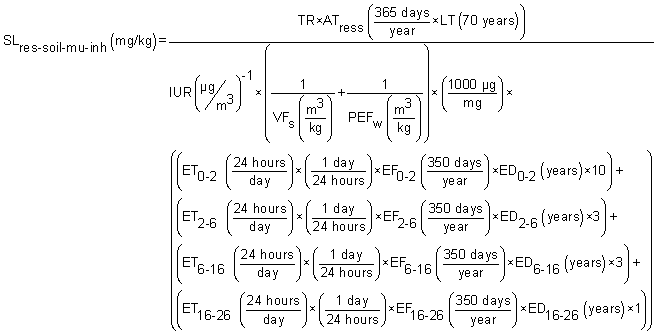
- dermal contact with soil,
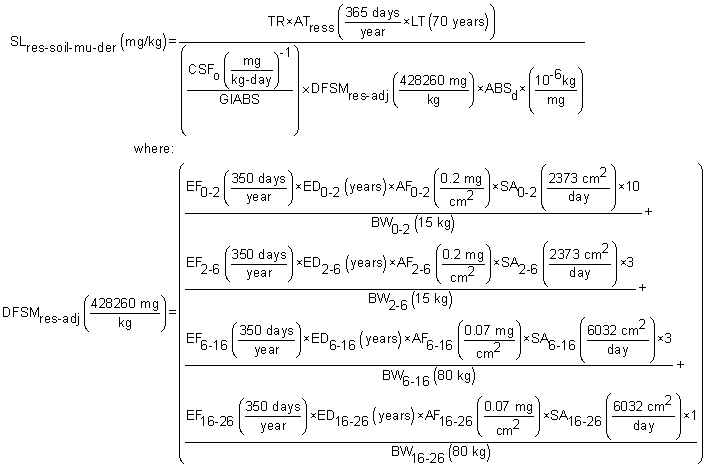
- Total.

4.1.5 Vinyl Chloride - Carcinogenic
The residential soil land use equations, presented here, contain the following exposure routes:
- incidental ingestion of soil,

- inhalation of volatiles and particulates emitted from soil,

- dermal contact with soil,

- Total.

4.1.6 Trichloroethylene - Carcinogenic and Mutagenic
The residential soil land use equations, presented here, contain the following exposure routes:
- incidental ingestion of soil,
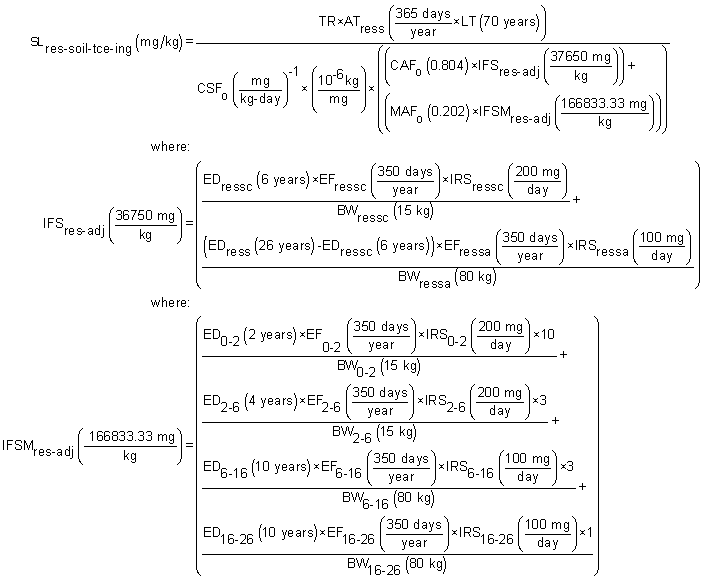
- inhalation of volatiles and particulates emitted from soil,

- dermal contact with soil,
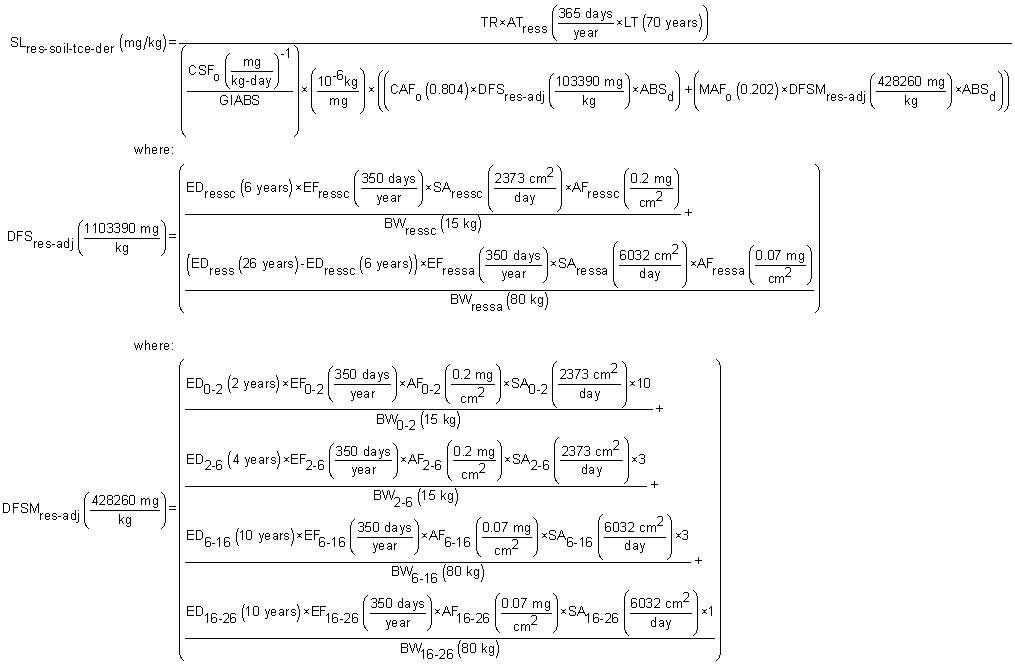
- Total.

A number of studies have shown that inadvertent ingestion of soil is common among children 6 years old and younger (Calabrese et al. 1989, Davis et al. 1990, Van Wijnen et al. 1990). Therefore, the dose method uses an age-adjusted soil ingestion factor that takes into account the difference in daily soil ingestion rates, body weights, and exposure duration for children from 1 to 6 years old and others from 7 to 26 years old. The equation is presented below. This health-protective approach is chosen to take into account the higher daily rates of soil ingestion in children as well as the longer duration of exposure that is anticipated for a long-term resident. For more on this method, see RAGS Part B.
4.1.7 Supporting Equations
- Child
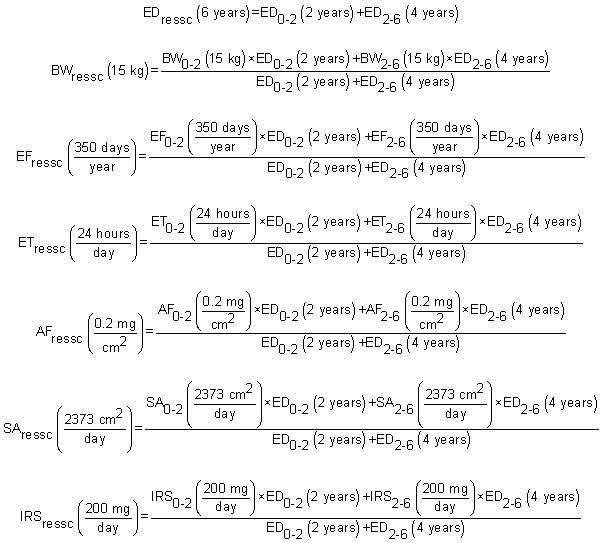
- Adult

- Age-adjusted
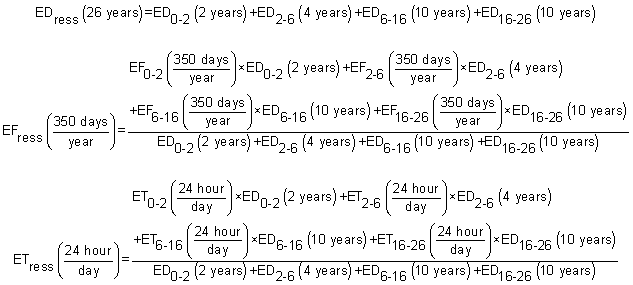
4.2 Composite Worker Soil
This land use is for developing industrial default screening levels that are presented in the Generic Tables.
4.2.1 Noncancer
The composite worker soil land use equation, presented here, contains the following exposure routes:
- incidental ingestion of soil,

- inhalation of volatiles and particulates emitted from soil,

- dermal exposure,

- Total.

4.2.2 Carcinogenic
The composite worker soil land use equation, presented here, contains the following exposure routes:
- incidental ingestion of soil,

- inhalation of volatiles and particulates emitted from soil,

- dermal exposure,

- Total.

4.3 Indoor Worker Soil
The indoor worker soil land use is not provided in the Generic Tables but SLs can be created by using the Calculator.
4.3.1 Noncancer
The indoor worker soil land use equation, presented here, contains the following exposure routes:
- incidental ingestion of soil,

- inhalation of volatiles and particulates emitted from soil,

- Total.

4.3.2 Carcinogenic
The indoor worker soil land use equation, presented here, contains the following exposure routes:
- incidental ingestion of soil,

- inhalation of volatiles and particulates emitted from soil,

- Total.

4.4 Outdoor Worker Soil
The outdoor worker soil land use is not provided in the Generic Tables but SLs can be created by using the Calculator.
4.4.1 Noncancer
The outdoor worker soil land use equation, presented here, contains the following exposure routes:
- incidental ingestion of soil,

- inhalation of volatiles and particulates emitted from soil,

- dermal exposure,

- Total.

4.4.2 Carcinogenic
The outdoor worker soil land use equation, presented here, contains the following exposure routes:
- incidental ingestion of soil,

- inhalation of volatiles and particulates emitted from soil,

- dermal exposure,

- Total.

4.5 Construction Worker Soil
The construction worker worker soil land use is not provided in the Generic Tables but SLs can be created by using the Calculator. The construction land use is described in the supplemental soil screening guidance. This land use is limited to an exposure duration of 1 year and is thus, subchronic. Other unique aspects of this scenario are that the PEF is based on mechanical disturbance of the soil and a special VF equation is used. Two types of mechanical soil disturbance are addressed: standard vehicle traffic and other than standard vehicle traffic (e.g. wind, grading, dozing, tilling and excavating). In general, the intakes and contact rates are all greater than the outdoor worker. Exhibit 5-1 in the supplemental soil screening guidance presents the exposure parameters.
4.5.1 Noncancer for Standard Vehicle Traffic
The construction worker soil land use equation, presented here, contains the following exposure routes:
- incidental ingestion of soil,

- inhalation of volatiles and particulates emitted from soil,

- dermal exposure,

- Total.

4.5.2 Carcinogenic for Standard Vehicle Traffic
The construction worker soil land use equation, presented here, contains the following exposure routes:
- incidental ingestion of soil,

- inhalation of volatiles and particulates emitted from soil,

- dermal exposure,

- Total.

4.5.3 Noncancer for Other than Standard Vehicle Traffic
The construction worker soil land use equation, presented here, contains the following exposure routes:
- incidental ingestion of soil,

- inhalation of volatiles and particulates emitted from soil,

- dermal exposure,

- Total.

4.5.2 Carcinogenic for Other than Standard Vehicle Traffic
The construction worker soil land use equation, presented here, contains the following exposure routes:
- incidental ingestion of soil,

- inhalation of volatiles and particulates emitted from soil,

- dermal exposure,

- Total.

4.6 Recreational Soil or Sediment
4.6.1 Noncancer - Child
The recreational soil or sediment land use equation, presented here, contains the following exposure routes:
- incidental ingestion of soil or sediment,

- inhalation of volatiles and particulates emitted from soil or sediment,

- dermal contact with soil or sediment,

- Total.

4.6.2 Noncancer - Adult
The recreational soil or sediment land use equation, presented here, contains the following exposure routes:
- incidental ingestion of soil or sediment,

- inhalation of volatiles and particulates emitted from soil or sediment,

- dermal contact with soil or sediment,

- Total.

4.6.3 Carcinogenic
The recreational soil or sediment land use equation, presented here, contains the following exposure routes:
- incidental ingestion of soil or sediment,

- inhalation of volatiles and particulates emitted from soil or sediment,

- dermal contact with soil or sediment,

- Total.

4.6.4 Mutagenic
The recreational soil or sediment land use equation, presented here, contains the following exposure routes:
- incidental ingestion of soil or sediment,

- inhalation of volatiles and particulates emitted from soil or sediment,
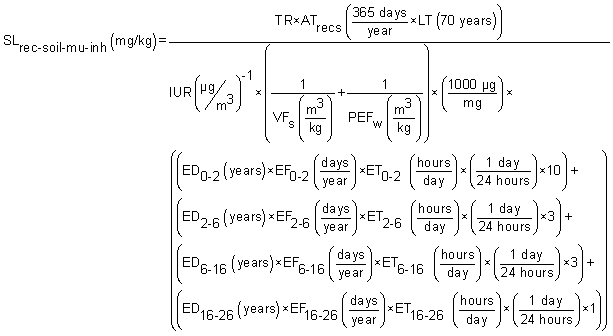
- dermal contact with soil or sediment,
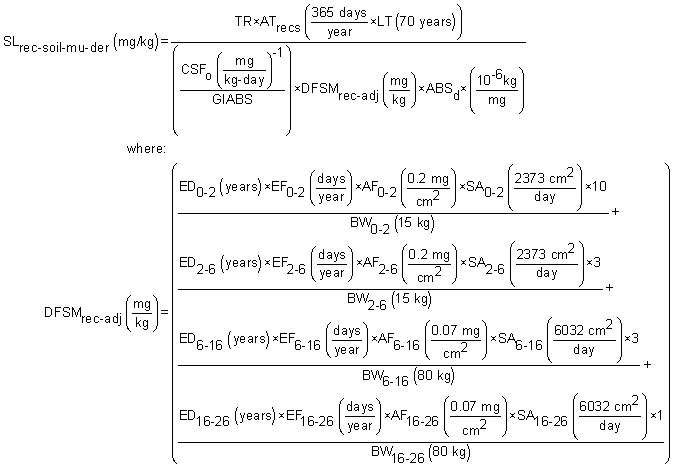
- Total.

4.6.5 Vinyl Chloride - Carcinogenic
The recreational soil or sediment land use equations, presented here, contain the following exposure routes:
- incidental ingestion of soil or sediment,
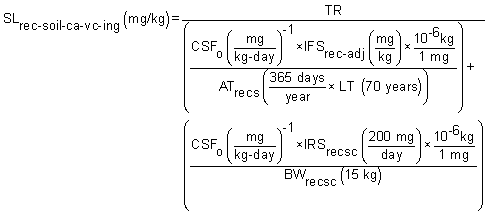
- inhalation of volatiles and particulates emitted from soil or sediment,

- dermal contact with soil or sediment,

- Total.

4.6.6 Trichloroethylene - Carcinogenic and Mutagenic
The recreational soil or sediment land use equations, presented here, contain the following exposure routes:
- incidental ingestion of soil or sediment,

- inhalation of volatiles and particulates emitted from soil or sediment,
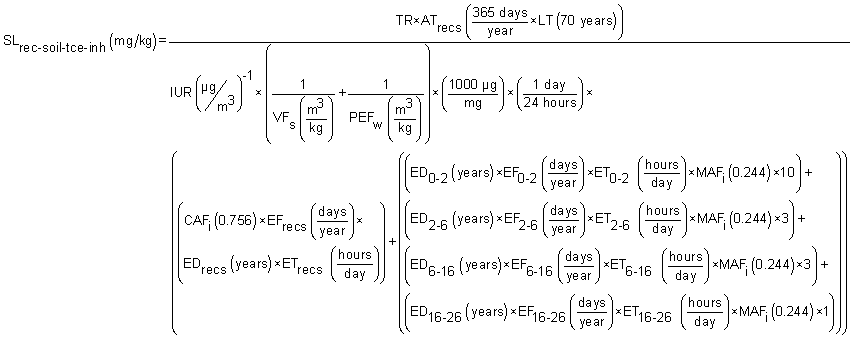
- dermal contact with soil or sediment,
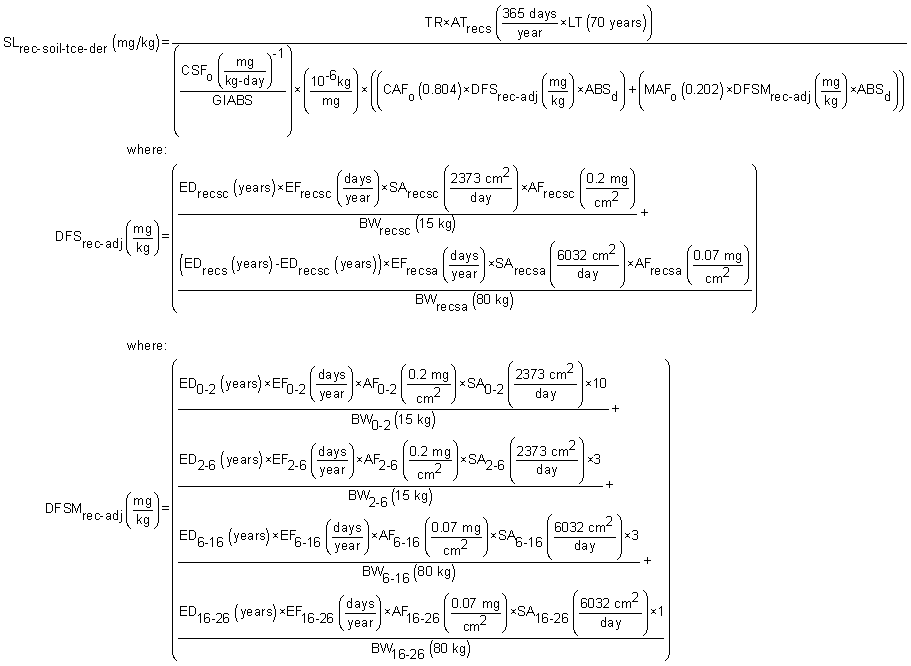
- Total.

A number of studies have shown that inadvertent ingestion of soil is common among children 6 years old and younger (Calabrese et al. 1989, Davis et al. 1990, Van Wijnen et al. 1990). Therefore, the dose method uses an age-adjusted soil ingestion factor that takes into account the difference in daily soil ingestion rates, body weights, and exposure duration for children from 1 to 6 years old and others from 7 to 26 years old. The equation is presented below. This health-protective approach is chosen to take into account the higher daily rates of soil ingestion in children as well as the longer duration of exposure that is anticipated for a long-term resident. For more on this method, see RAGS Part B.
4.6.7 Supporting Equations
- Child
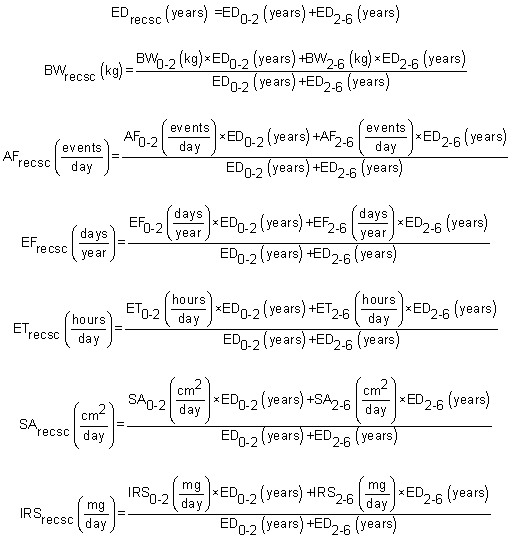
- Adult
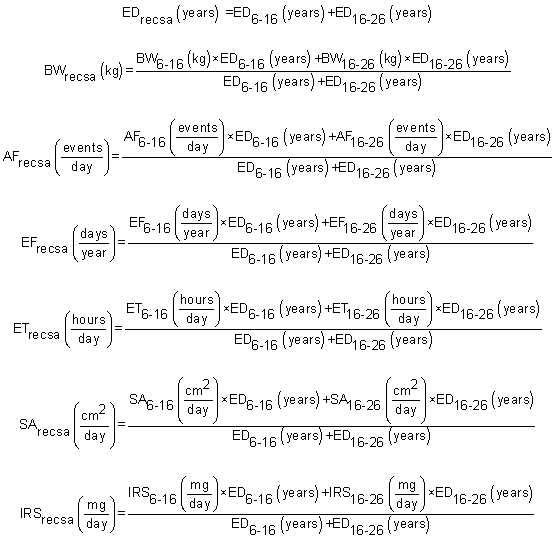
- Age-adjusted

4.7 Recreational Surface Water
4.7.1 Noncarcinogenic - Child
The surface water land use equation, presented here, contains the following exposure routes:
- incidental ingestion of water,

- dermal,
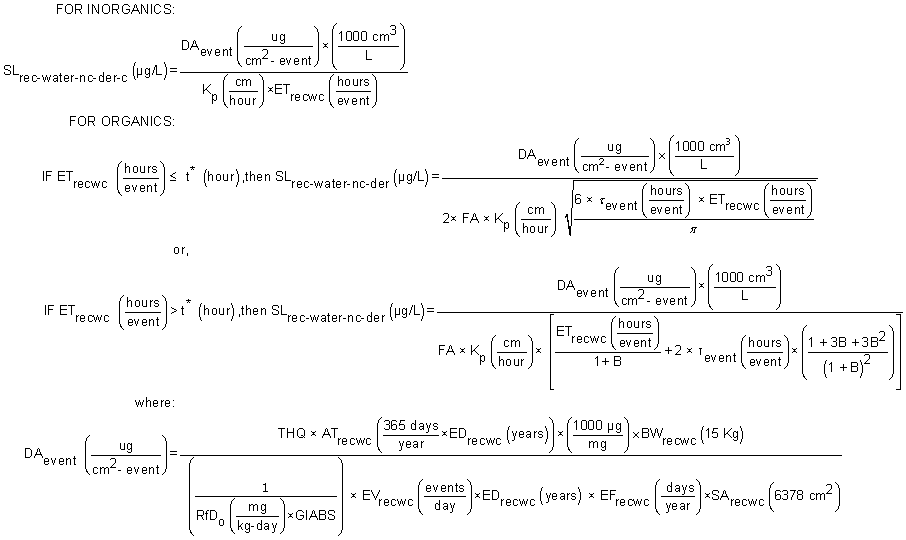
- Total.

4.7.2 Noncarcinogenic - Adult
The surface water land use equation, presented here, contains the following exposure routes:
- incidental ingestion of water,

- dermal,

- Total.

4.7.3 Carcinogenic
The surface water land use equation, presented here, contains the following exposure routes:
- incidental ingestion of water,

- dermal,
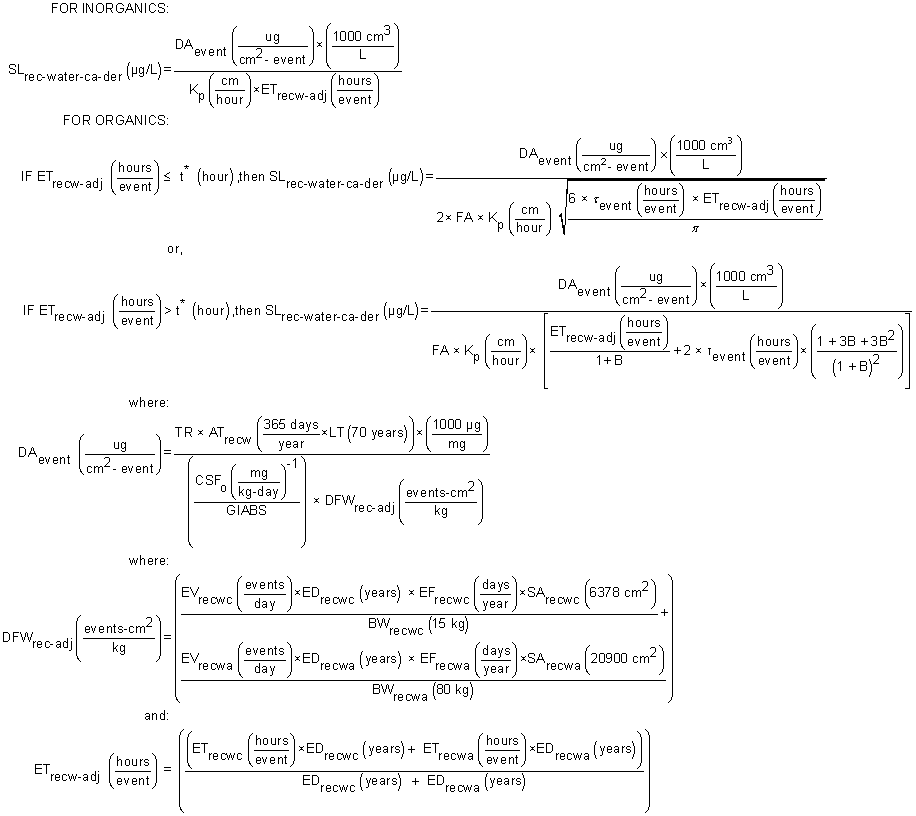
- Total.

4.7.4 Mutagenic
The surface water land use equation, presented here, contains the following exposure routes:
- incidental ingestion of water,

- dermal,
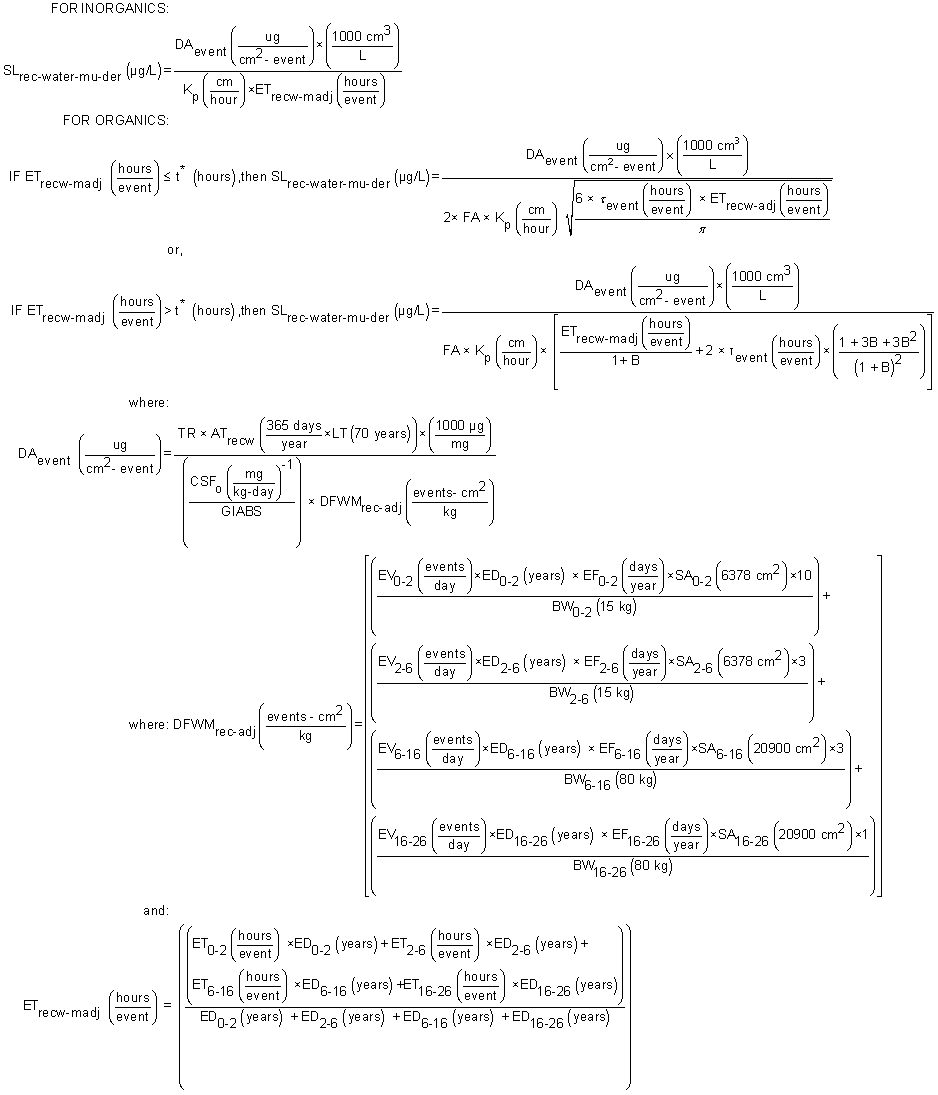
- Total.

4.7.5 Vinyl Chloride - Carcinogenic
The surface water land use equation, presented here, contains the following exposure routes:
- incidental ingestion of water,

- dermal,
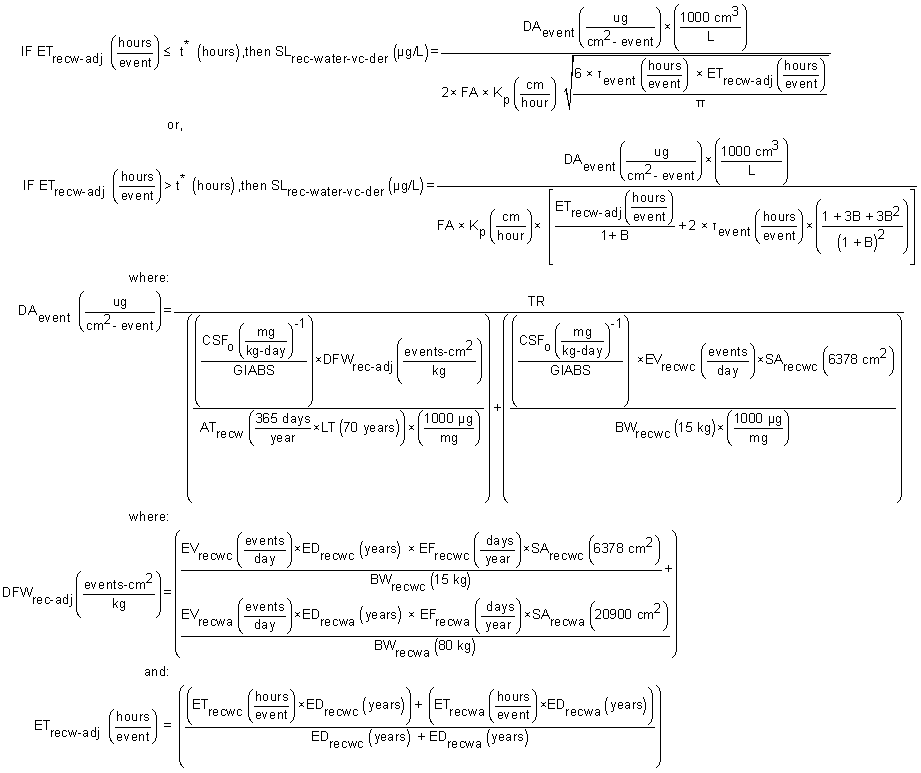
- Total.

4.7.6 Trichloroethylene - Carcinogenic and Mutagenic
The surface water land use equation, presented here, contains the following exposure routes:
- incidental ingestion of water,
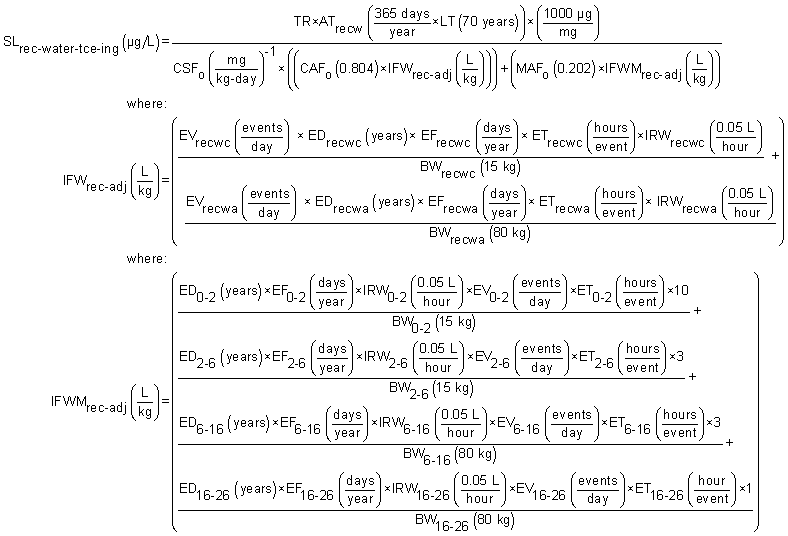
- dermal,
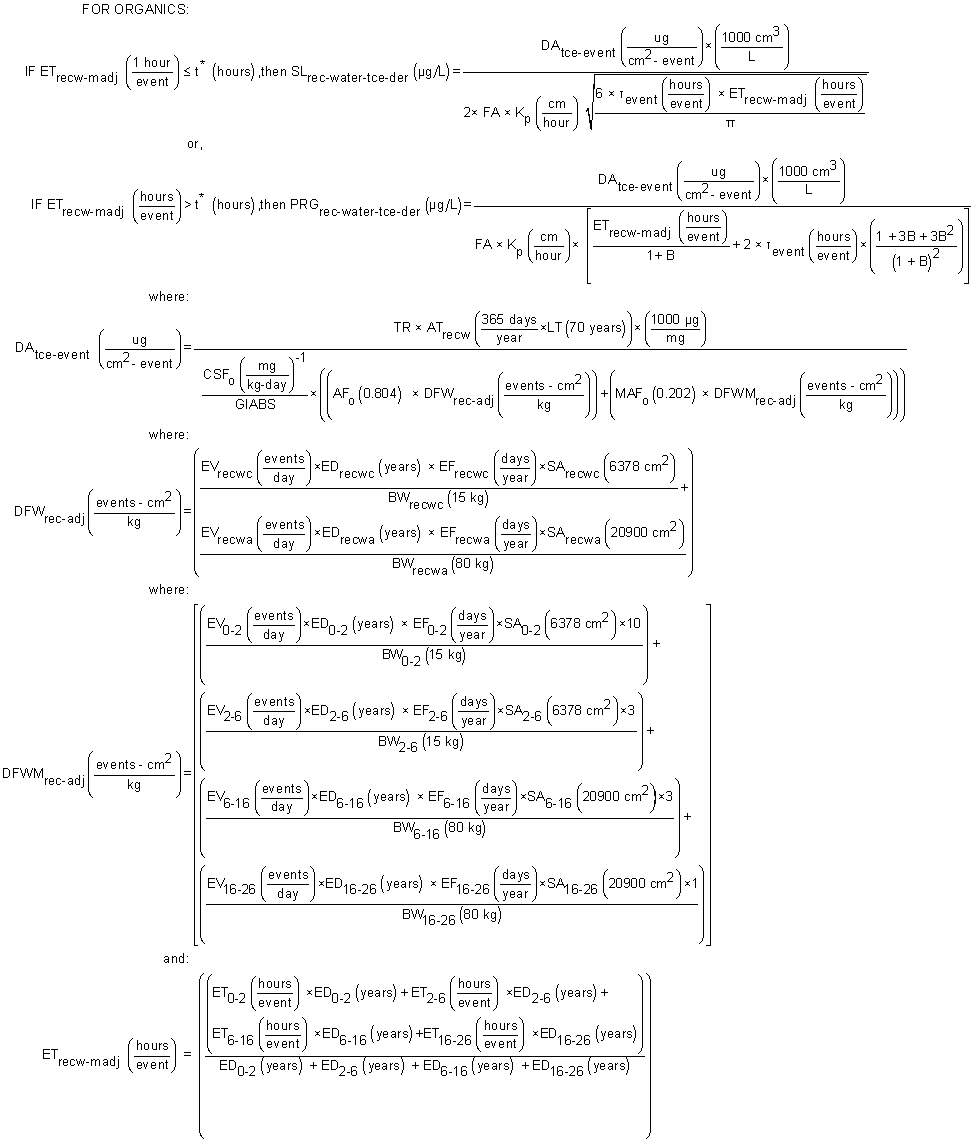
- Total.

4.7.7 Supporting Equations
- Child

- Adult

4.8 Tapwater
4.8.1 Noncarcinogenic-child
The tapwater land use equation, presented here, contains the following exposure routes:
- ingestion of water,

- dermal,
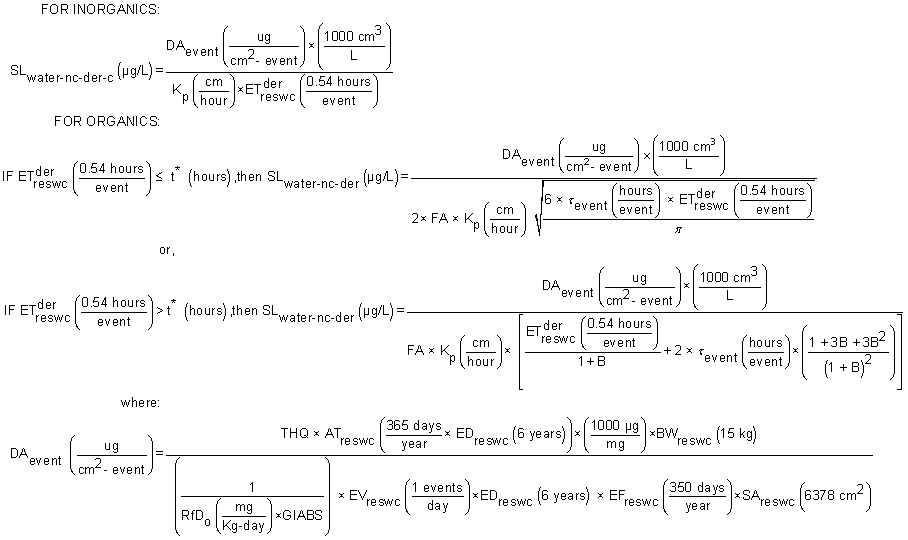
- inhalation of volatiles,

- Total.

4.8.2 Noncarcinogenic-adult
The tapwater land use equation, presented here, contains the following exposure routes:
- ingestion of water,

- dermal,
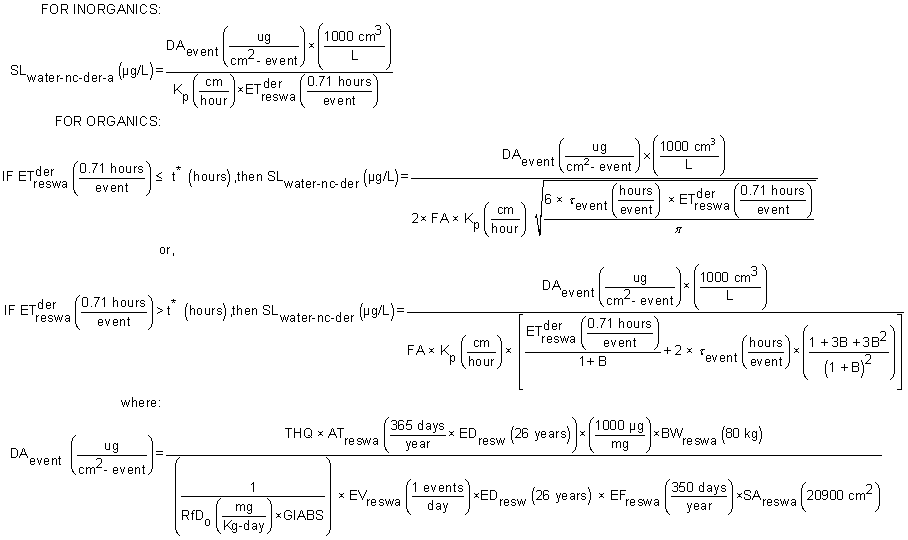
- inhalation of volatiles,

- Total.

4.8.3 Carcinogenic
The tapwater land use equation, presented here, contains the following exposure routes:
- ingestion of water,
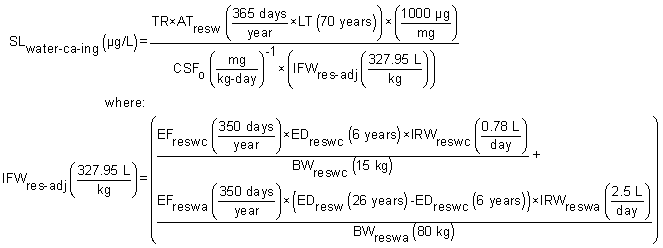
- dermal,
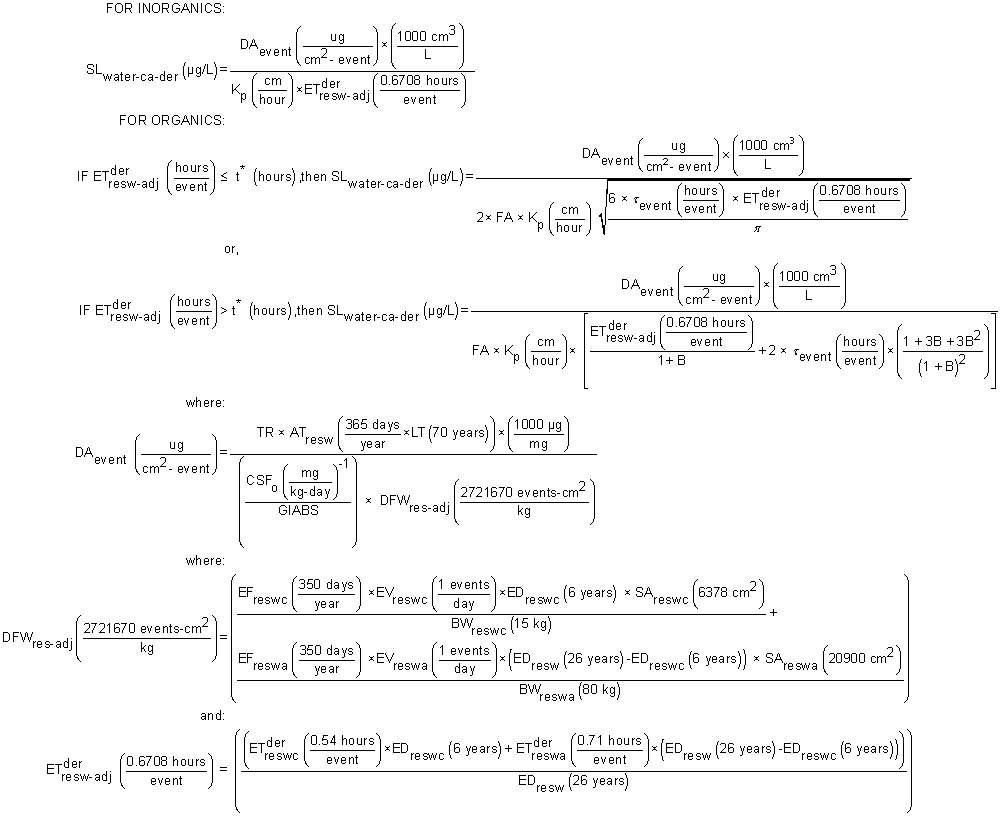
- inhalation of volatiles,

- Total.

4.8.4 Mutagenic
The tapwater land use equation, presented here, contains the following exposure routes:
- ingestion of water,

- dermal,
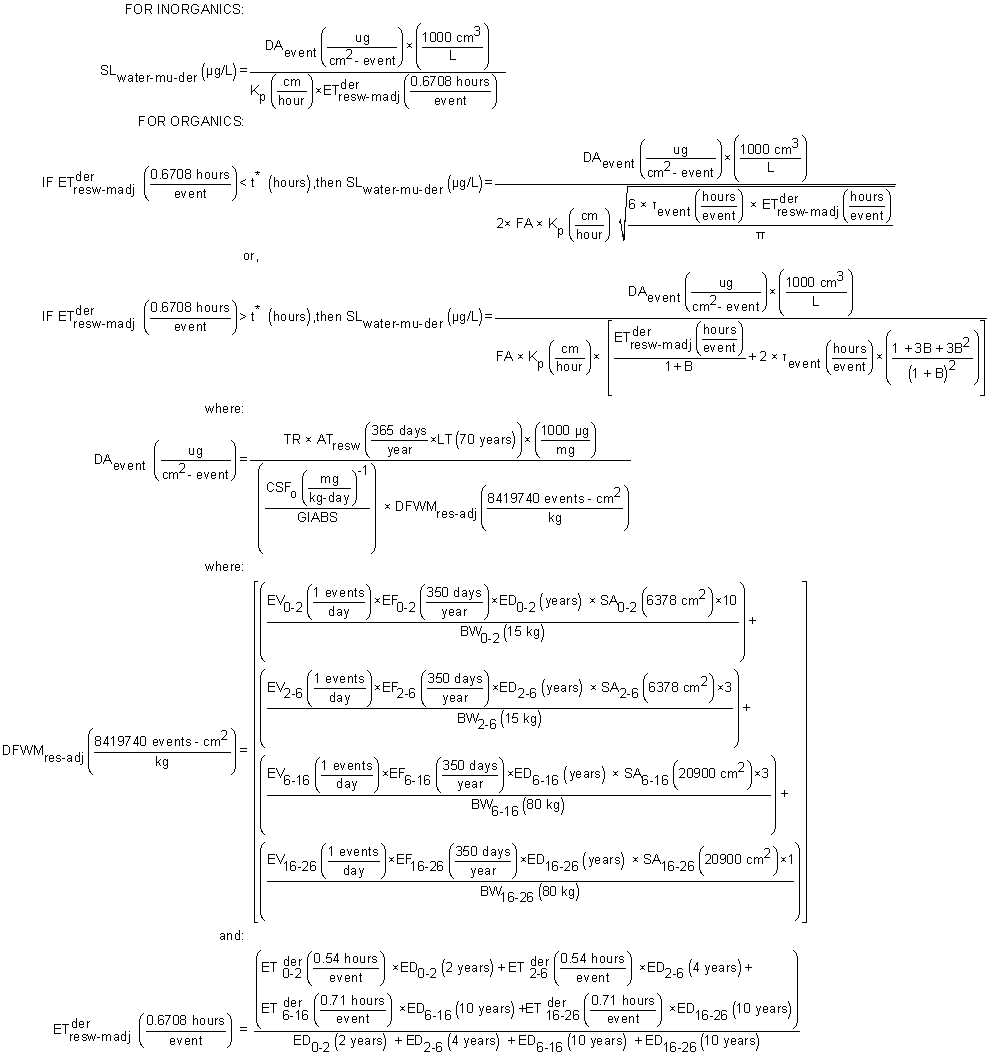
- inhalation of volatiles,

- Total.

4.8.5 Vinyl Chloride - Carcinogenic
The tapwater land use equation, presented here, contains the following exposure routes:
- ingestion of water,

- dermal,
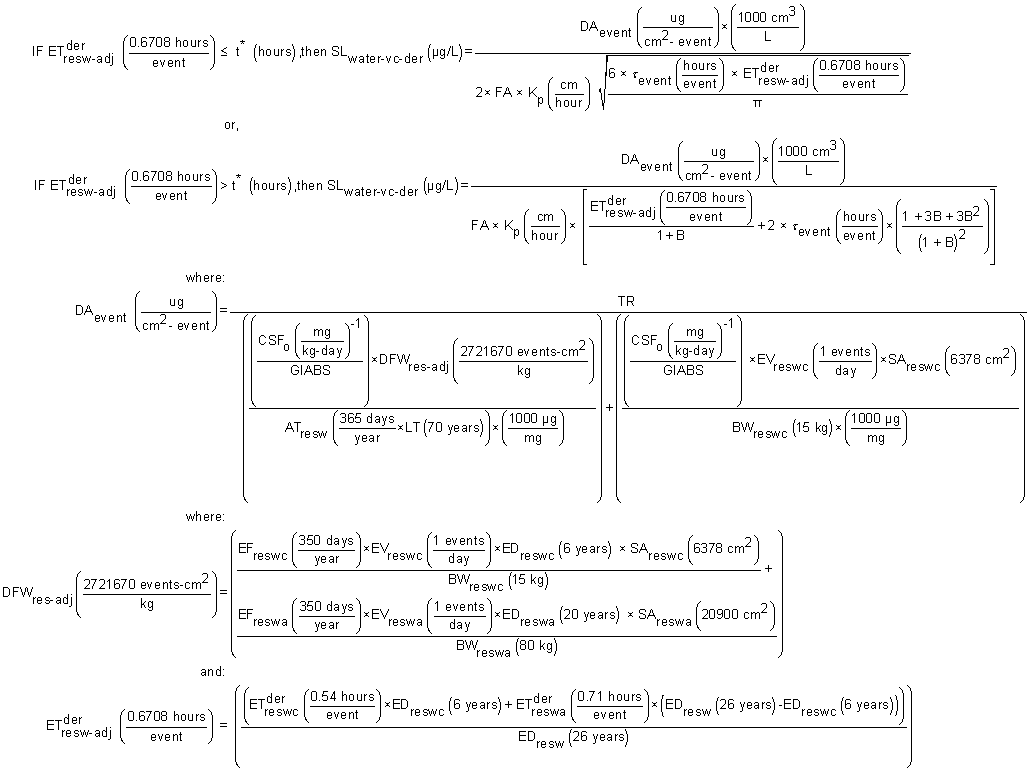
- inhalation of volatiles,

- Total.

4.8.6 Trichloroethylene - Carcinogenic and Mutagenic
The tapwater land use equation, presented here, contains the following exposure routes:
- ingestion of water,

- dermal,
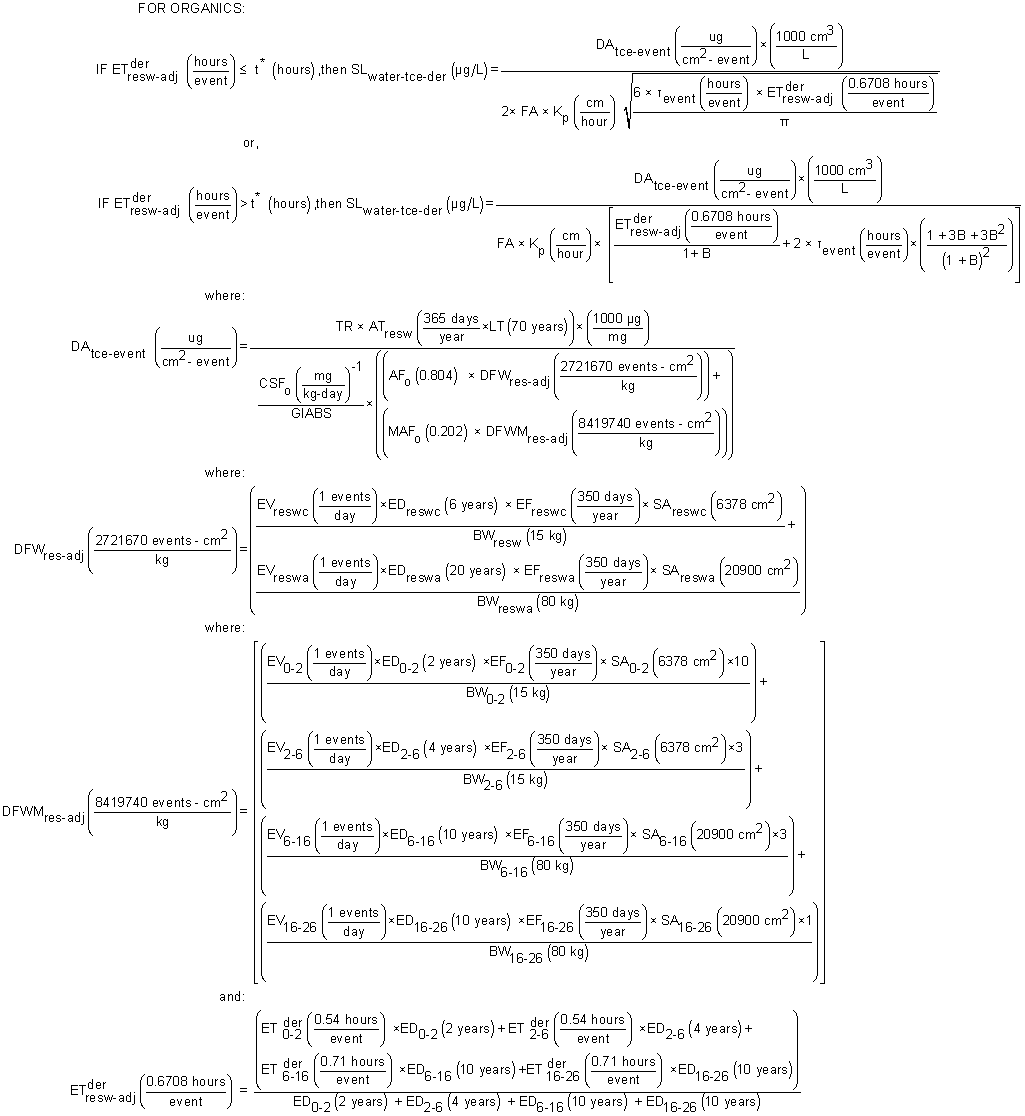
- inhalation of volatiles,
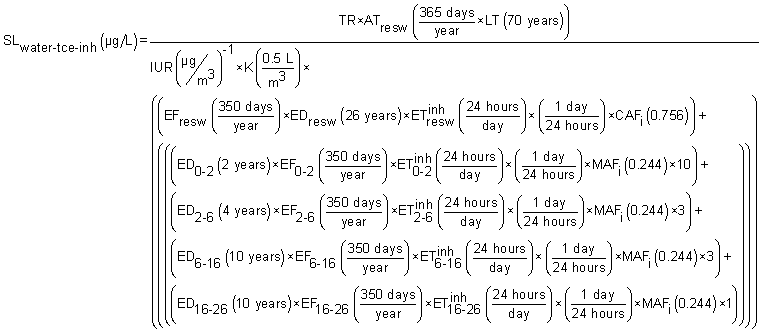
- Total.

4.8.7 Supporting Equations
- Child
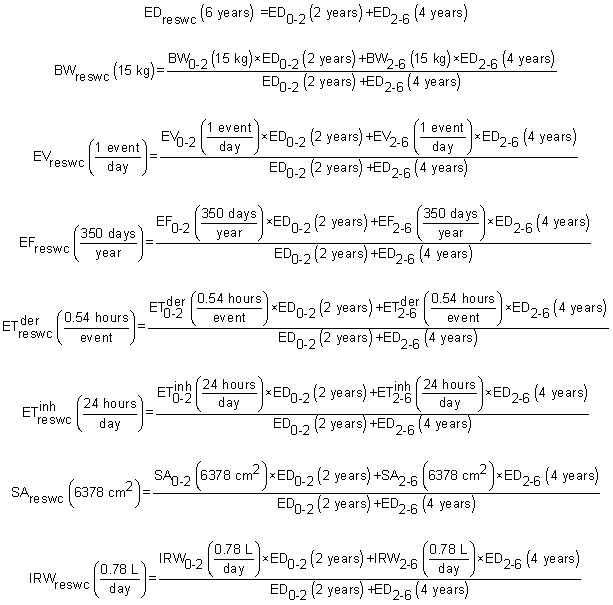
- Adult
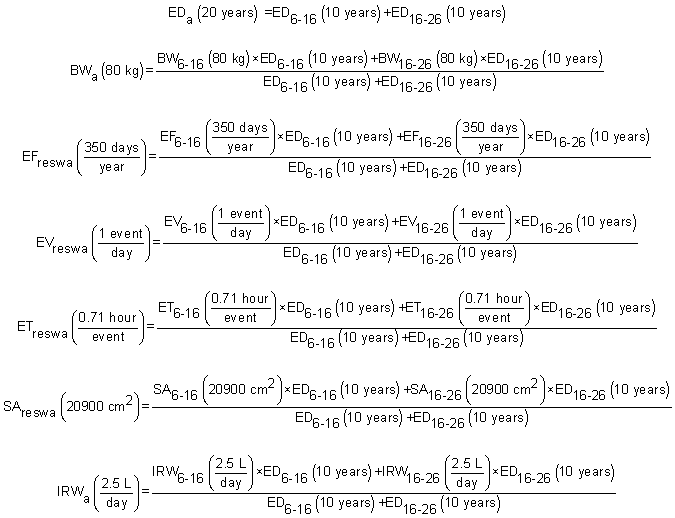
- Age-adjusted
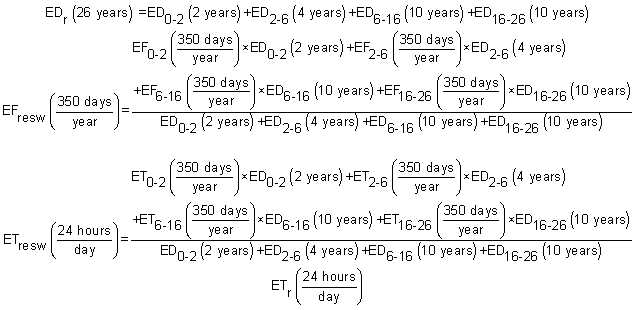
4.9 Resident air
4.9.1 Noncarcinogenic
The air land use equation, presented here, contains the following exposure routes:
- inhalation

4.9.2 Carcinogenic
The air land use equation, presented here, contains the following exposure routes:
- inhalation

4.9.3 Mutagenic
The air land use equation, presented here, contains the following exposure routes:
- inhalation
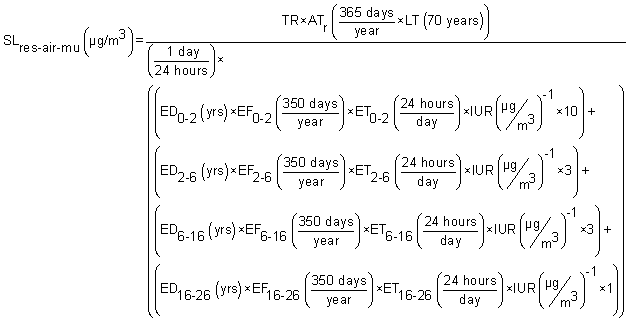
4.9.4 Vinyl Chloride - Carcinogenic
The air land use equation, presented here, contains the following exposure routes:
- inhalation

4.9.5 Trichloroethylene - Carcinogenic and Mutagenic
The air land use equation, presented here, contains the following exposure routes:
- inhalation
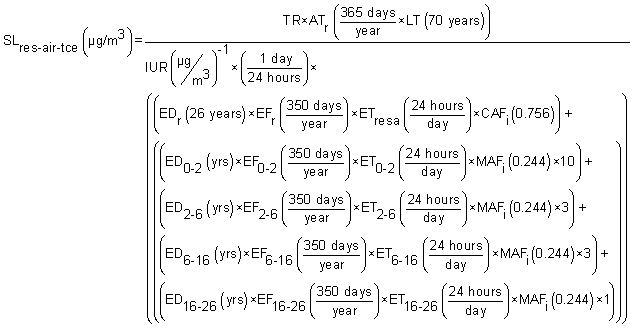
4.10 Worker air
4.10.1 Noncarcinogenic
The air land use equation, presented here, contains the following exposure routes:
- Inhalation

4.10.2 Carcinogenic
The air land use equation, presented here, contains the following exposure routes:
- Inhalation

4.11 Ingestion of Fish
The ingestion of fish exposure route is not provided in the Generic Tables but SLs can be created by using the Calculator and the equations that follow:
4.11.1 Noncarcinogenic
The ingestion of fish equation, presented here, contains the following exposure route:
- consumption of fish.

4.11.2 Carcinogenic
The ingestion of fish equation, presented here, contains the following exposure route:
- consumption of fish.

Note: the consumption rate for fish is not age adjusted for this land use. Also the SL calculated for fish is not for soil but is for fish tissue.
4.12 Soil to Groundwater
These equations are used to calculate screening levels in soil (SSLs) that are protective of groundwater. SSLs are either back-calculated from protective risk-based ground water concentrations or based on MCLs. The SSLs were designed for use during the early stages of a site evaluation when information about subsurface conditions may be limited. Because of this constraint, the equations used are based on conservative, simplifying assumptions about the release and transport of contaminants in the subsurface. Migration of contaminants from soil to groundwater can be envisioned as a two-stage process: (1) release of contaminant in soil leachate and (2) transport of the contaminant through the underlying soil and aquifer to a receptor well. The SSL methodology considers both of these fate and transport mechanisms.
The SSLs protective of groundwater, provided in the generic tables and the calculator, are all risk-based concentrations based on three phases (vapor, soil and water). No substitution for Csat is performed. If the risk-based concentration exceeds Csat, the resulting SSL concentration may be overly protective. This is because the dissolved, absorbed and vapor concentrations cease to rise linearly as soil concentration increases above the Csat level (pure product or nonaqueous phase liquid (NAPL) is present). The SSL model used in the RSL calculator is not a four phase model. If a NAPL is present at your site more sophisticated models may be necessary.
SSLs are provided for metals in the Generic Tables based on Kds from the Soil Screening Guidance Exhibit C-4 . According to Appendix C,
"Exhibit C-4 provides pH-specific soil-water partition coefficients (Kd) for metals. Site-specific soil pH measurements can be used to select appropriate Kd values for these metals. Where site-specific soil pH values are not available, values corresponding to a pH of 6.8 should be used."
If a metal is not listed in Exhibit C-4, Kds were taken from Baes, C. F. 1984. Kds for organic coumponds are calculated from Koc and the fraction of organic carbon in the soil (foc). Kds for metals are listed below.
| Chemical | CAS | Kd |
Reference |
| Aluminum | 7429-90-5 | 1.50E+03 |
Baes, C.F. 1984 |
| Antimony (metallic) | 7440-36-0 | 4.50E+01 |
SSG 9355.4-23 July 1996 |
| Arsenic, Inorganic | 7440-38-2 | 2.90E+01 |
SSG 9355.4-23 July 1996 |
| Barium | 7440-39-3 | 4.10E+01 |
SSG 9355.4-23 July 1996 |
| Beryllium and compounds | 7440-41-7 | 7.90E+02 |
SSG 9355.4-23 July 1996 |
| Boron And Borates Only | 7440-42-8 | 3.00E+00 |
Baes, C.F. 1984 |
| Bromate | 15541-45-4 | 7.50E+00 |
Baes, C.F. 1984 |
| Cadmium (Diet) | 7440-43-9 | 7.50E+01 |
SSG 9355.4-23 July 1996 |
| Cadmium (Water) | 7440-43-9 | 7.50E+01 |
SSG 9355.4-23 July 1996 |
| Chlorine | 7782-50-5 | 2.50E-01 |
Baes, C.F. 1984 |
| Chromium (III) (Insoluble Salts) | 16065-83-1 | 1.80E+06 |
SSG 9355.4-23 July 1996 |
| Chromium Salts | 0-00-3 | 8.50E+02 |
Baes, C.F. 1984 |
| Chromium VI (chromic acid mists) | 18540-29-9 | 1.90E+01 |
SSG 9355.4-23 July 1996 |
| Chromium VI (particulates) | 18540-29-9 | 1.90E+01 |
SSG 9355.4-23 July 1996 |
| Chromium, Total (1:6 ratio Cr VI : Cr III) | 7440-47-3 | 1.80E+06 |
SSG 9355.4-23 July 1996 |
| Cobalt | 7440-48-4 | 4.50E+01 |
Baes, C.F. 1984 |
| Copper | 7440-50-8 | 3.50E+01 |
Baes, C.F. 1984 |
| Cyanide (CN-) | 57-12-5 | 9.90E+00 |
SSG 9355.4-23 July 1996 |
| Fluorine (Soluble Fluoride) | 7782-41-4 | 1.50E+02 |
Baes, C.F. 1984 |
| Hydrogen Cyanide (HCN) | 74-90-8 | 9.90E+00 |
Surrogate value from Cyanide |
| Iron | 7439-89-6 | 2.50E+01 |
Baes, C.F. 1984 |
| Lead and Compounds | 7439-92-1 | 9.00E+02 |
Baes, C.F. 1984 |
| Lithium | 7439-93-2 | 3.00E+02 |
Baes, C.F. 1984 |
| Magnesium | 7439-95-4 | 4.50E+00 |
Baes, C.F. 1984 |
| Manganese (Diet) | 7439-96-5 | 6.50E+01 |
Baes, C.F. 1984 |
| Manganese (Water) | 7439-96-5 | 6.50E+01 |
Baes, C.F. 1984 |
| Mercury (elemental) | 7439-97-6 | 5.20E+01 |
SSG 9355.4-23 July 1996 |
| Mercury, Inorganic Salts | 0-01-7 | 5.20E+01 |
SSG 9355.4-23 July 1996 |
| Molybdenum | 7439-98-7 | 2.00E+01 |
Baes, C.F. 1984 |
| Nickel Soluble Salts | 7440-02-0 | 6.50E+01 |
SSG 9355.4-23 July 1996 |
| Phosphorus, White | 7723-14-0 | 3.50E+00 |
Baes, C.F. 1984 |
| Selenium | 7782-49-2 | 5.00E+00 |
SSG 9355.4-23 July 1996 |
| Silver | 7440-22-4 | 8.30E+00 |
SSG 9355.4-23 July 1996 |
| Sodium | 7440-23-5 | 1.00E+02 |
Baes, C.F. 1984 |
| Strontium, Stable | 7440-24-6 | 3.50E+01 |
Baes, C.F. 1984 |
| Thallium (Soluble Salts) | 7440-28-0 | 7.10E+01 |
SSG 9355.4-23 July 1996 |
| Thorium | 0-23-2 | 1.50E+05 |
Baes, C.F. 1984 |
| Tin | 7440-31-5 | 2.50E+02 |
Baes, C.F. 1984 |
| Titanium | 7440-32-6 | 1.00E+03 |
Baes, C.F. 1984 |
| Uranium (Soluble Salts) | 0-23-8 | 4.50E+02 |
Baes, C.F. 1984 |
| Vanadium and Compounds | 0-06-6 | 1.00E+03 |
SSG 9355.4-23 July 1996 |
| Vanadium, Metallic | 7440-62-2 | 1.00E+03 |
SSG 9355.4-23 July 1996 |
| Zinc (Metallic) | 7440-66-6 | 6.20E+01 |
SSG 9355.4-23 July 1996 |
| Zirconium | 7440-67-7 | 3.00E+03 |
Baes, C.F. 1984 |
Because Kds vary greatly by soil type, it is highly recommended that site-specific Kds be determined and used to develop SSLs.
The more protective of the carcinogenic and noncarcinogenic SLs is selected to calculate the SSL.
4.12.1 Noncarcinogenic Tapwater Equations for SSLs
The tapwater equations, presented in Section 4.7.1, are used to calculate the noncarcinogenic SSLs for volatiles and nonvolatiles. If the contaminant is a volatile, ingestion, dermal and inhalation exposure routes are considered. If the contaminant is not a volatile, only ingestion and dermal are considered.
4.12.2 Carcinogenic Tapwater Equations for SSLs
The tapwater equations, presented in Section 4.7.2, are used to calculate the carcinogenic SSLs for volatiles and nonvolatiles. Sections 4.7.3 and 4.7.4 present the mutagenic and vinyl chloride equations, respectively. If the contaminant is a volatile, ingestion, dermal and inhalation exposure routes are considered. If the contaminant is not a volatile, only ingestion and dermal are considered.
4.12.3 Method 1 for SSL Determination
Method 1 employs a partitioning equation for migration to groundwater and defaults are provided. This method is used to generate the download default tables.
- method 1.
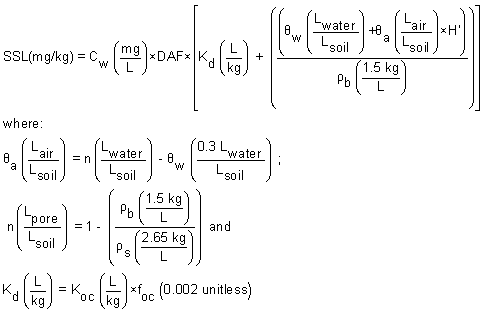
4.12.4 Method 2 for SSL Determination
Method 2 employs a mass-limit equation for migration to groundwater and site-specific information is required. This method can be used in the calculator portion of this website.
- method 2.

4.12.5 Determination of the Dilution Factor
The SSL values in the download tables are based on a dilution factor of 1. If one wishes to use the calculator to calculate screening levels using the SSL guidance for a source up to 0.5 acres, then a dilution factor of 20 can be used. If all of the parameters needed to calculate a site-specific dilution factor are known, they may be entered.
- dilution factor.
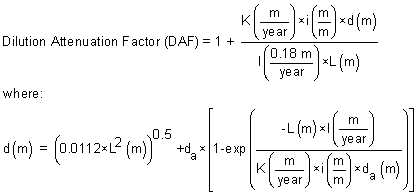
4.13 Supporting Equations and Parameter Discussion
There are two parts of the above land use equations that require further explanation. They are the inhalation variables: the particulate emission factor (PEF) and the volatilization factor (VF).
4.13.1 Wind-driven Particulate Emission Factor (PEF)
Inhalation of contaminants adsorbed to respirable particles (PM10) was assessed using a default PEF equal to 1.36 x 109 m3/kg. This equation relates the contaminant concentration in soil with the concentration of respirable particles in the air due to fugitive dust emissions from contaminated soils. The generic PEF was derived using default values that correspond to a receptor point concentration of approximately 0.76 µg/m3. The relationship is derived by Cowherd (1985) for a rapid assessment procedure applicable to a typical hazardous waste site, where the surface contamination provides a relatively continuous and constant potential for emission over an extended period of time (e.g., years). This represents an annual average emission rate based on wind erosion that should be compared with chronic health criteria; it is not appropriate for evaluating the potential for more acute exposures. Definitions of the input variables are in Table 1.
With the exception of specific heavy metals, the PEF does not appear to significantly affect most soil screening levels. The equation forms the basis for deriving a generic PEF for the inhalation pathway. For more details regarding specific parameters used in the PEF model, refer to Soil Screening Guidance: Technical Background Document. The use of alternate values on a specific site should be justified and presented in an Administrative Record if considered in CERCLA remedy selection.
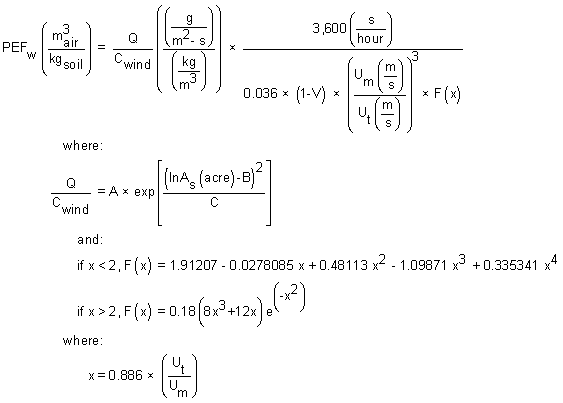
Note: the generic PEF evaluates wind-borne emissions and does not consider dust emissions from traffic or other forms of mechanical disturbance that could lead to greater emissions than assumed here.
4.13.2 Vehicle traffic-driven Particulate Emission Factor (PEFsc)
The equation to calculate the subchronic particulate emission factor (PEFsc) is significantly different from the residential and non-residential PEF equations. The PEFsc focuses exclusively on emissions from truck traffic on unpaved roads, which typically contribute the majority of dust emissions during construction. This equation requires estimates of parameters such as the number of days with at least 0.01 inches of rainfall, the mean vehicle weight, and the sum of fleet vehicle distance traveled during construction.
The number of days with at least 0.01 inches of rainfall can be estimated using Exhibit 5-2 in the supplemental soil screening guidance. . Mean vehicle weight (W) can be estimated by assuming the numbers and weights of different types of vehicles. For example, assuming that the daily unpaved road traffic consists of 20 two-ton cars and 10 twenty-ton trucks, the mean vehicle weight would be:
W = [(20 cars x 2 tons/car) + (10 trucks x 20 tons/truck)]/30 vehicles = 8 tons
The sum of the fleet vehicle kilometers traveled during construction (∑ VKT) can be estimated based on the size of the area of surface soil contamination, assuming the configuration of the unpaved road, and the amount of vehicle traffic on the road. For example, if the area of surface soil contamination is 0.5 acres (or 2,024 m2), and one assumes that this area is configured as a square with the unpaved road segment dividing the square evenly, the road length would be equal to the square root of 2,024 m2, 45 m (or 0.045 km). Assuming that each vehicle travels the length of the road once per day, 5 days per week for a total of 6 months, the total fleet vehicle kilometers traveled would be:
∑ VKT = 30 vehicles x 0.045 km/day x (52 wks/yr ÷ 2) x 5 days/wk = 175.5 km
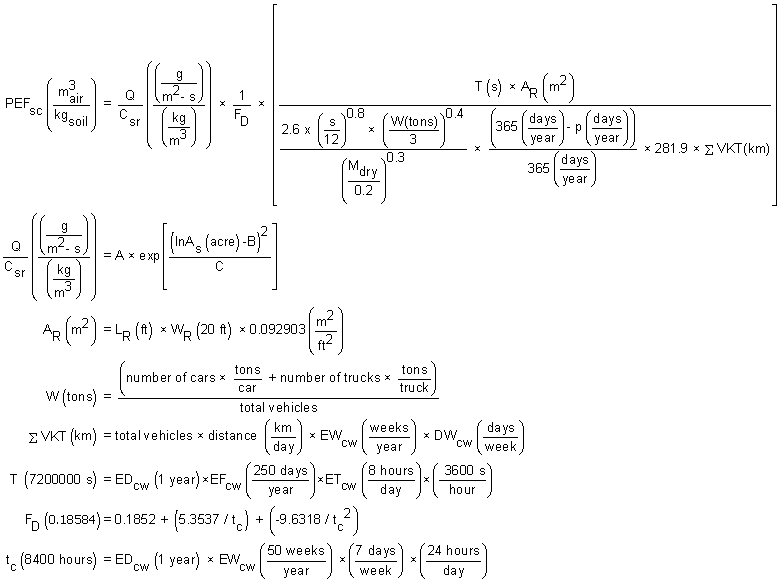
4.13.3 Other than vehicle traffic-driven Particulate Emission Factor (PEF'sc)
Other than emissions from unpaved road traffic, the construction worker may also be exposed to particulate matter emissions from wind erosion, excavation soil dumping, dozing, grading, and tilling or similar operations PEF'sc. These operations may occur separately or concurrently and the duration of each operation may be different. For these reasons, the total unit mass emitted from each operation is calculated separately and the sum is normalized over the entire area of contamination and over the entire time during which construction activities take place. Equation E-26 in the supplemental soil screening guidance was used.

4.13.4 Infinite Source Chronic Volatilization Factor (VF)
The soil-to-air VF is used to define the relationship between the concentration of the contaminant in soil and the flux of the volatilized contaminant to air. VF is calculated from the equation below using chemical-specific properties and either site-measured or default values for soil moisture, dry bulk density, and fraction of organic carbon in soil. The Soil Screening Guidance: User's Guide describes how to develop site measured values for these parameters.
VF is only calculated for volatile compounds. Volatiles, for the purpose of this guidance, are chemicals with a Henry's Law constant greater than or equal to 1 x 10-5 atm-m3/mole or a vapor pressure greater than or equal to 1 mm Hg. The volatile status of a chemical is important for some exposure routes. According to RAGS Part E, dermal absorption to soil is not assessed for volatiles. For the purposes of this guidance, dermal exposure to soil is only quantified if RAGS Part E provides a dermal absorption value in Exhibit 3-4 or the website, regardless of volatility status. The rationale for this is that in the considered soil exposure scenarios, volatile organic compounds would tend to be volatilized from the soil on skin and should be accounted for via inhalation routes in the combined exposure pathway analysis. Further, a chemical must be volatile in order to be included in the calculation of tapwater inhalation.
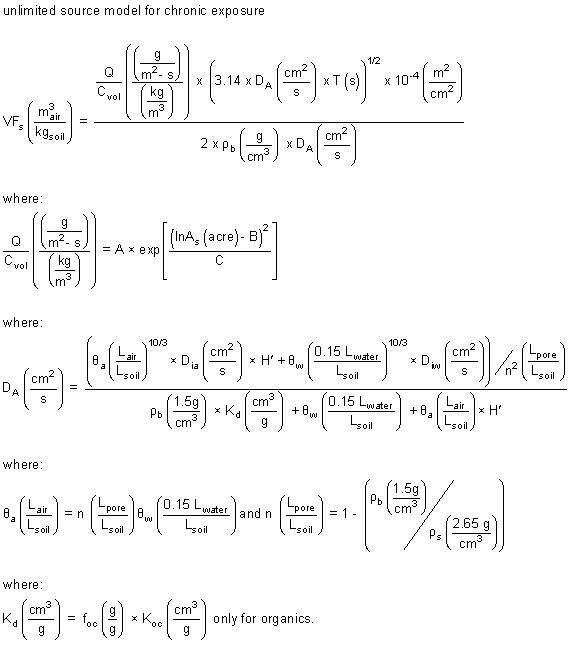
Diffusivity in Water (cm2/s)
Diffusivity in water can be calculated from the chemical's molecular weight and density, using the following correlation equation based on WATER9 (U.S. EPA, 2001):

If density is not available, diffusivity in water can be calculated using the correlation equation based on U.S. EPA (1987). The value for diffusivity in water must be greater than zero. No maximum limit is enforced.
Diffusivity in Air (cm2/s).
Diffusivity in air can be calculated from the chemical's molecular weight and density, using the following correlation equation based on WATER9 (U.S. EPA, 2001):
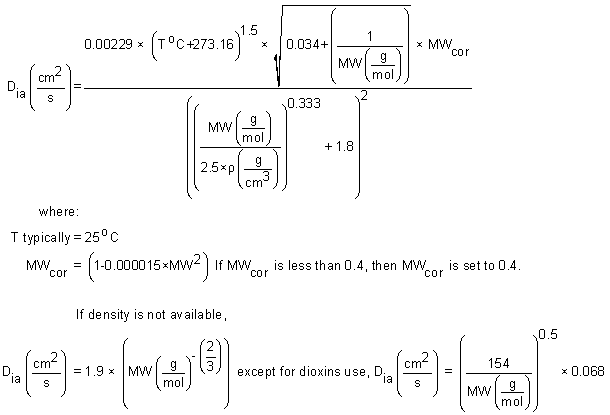
If density is not available, diffusivity in air can be calculated using the correlation equation based on U.S. EPA (1987). For dioxins, diffusivity in air can be calculated from the molecular weight using the correlation equation based on EPA's Dioxin Reassessment (U.S. EPA, 2000).
4.13.5 Mass-limit Chronic Volatilization Factor (VF)
This Equation presents a model for calculating mass-limit SSLs for the outdoor inhalation of volatiles. This model can be used only if the depth and area of contamination are known or can be estimated with confidence. This equation is presented in the Soil Screening Guidance: User's Guide and the Supplemental Soil Screening Guidance.
Use of infinite source models to estimate volatilization can violate mass balance considerations, especially for small sources. To address this concern, the Soil Screening Guidance includes a model for calculating a mass-limit SSL that provides a lower limit to the SSL when the area and depth (i.e., volume) of the source are known or can be estimated reliably.
A mass-limit SSL represents the level of contaminant in the subsurface that is still protective when the entire volume of contamination volatilizes over the 30-year exposure duration and the level of contaminant at the receptor does not exceed the health-based limit.
To use mass-limit SSLs, determine the area and depth of the source, calculate both standard and mass-limit SSLs, compare them for each chemical of concern and select the higher of the two values.
Note that the equation requires a site-specific determination of the average depth of contamination in the source. Step 3, in the SSG, provides guidance for conducting subsurface sampling to determine source depth. Where the actual average depth of contamination is uncertain, a conservative estimate should be used (e.g., the maximum possible depth in the unsaturated zone). At many sites, the average water table depth may be used unless there is reason to believe that contamination extends below the water table. In this case SSLs do not apply and further investigation of the source in question is needed.
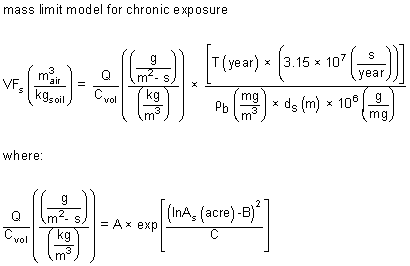
4.13.6 Unlimited Source Subchronic Volatilization Factor for Construction Worker (VFsc)
Equation 5-14 of the supplemental soil screening guidance is appropriate for calculating the soil-to-air volatilization factor (VFsc) that relates the concentration of a contaminant in soil to the concentration in air resulting from volatilization. The equation for the subchronic dispersion factor for volatiles, Q/Csa, is presented in Equation 5-15 of the supplemental soil screening guidance. Q/Csa was derived using EPA's SCREEN3 dispersion model for a hypothetical site under a wide range of meteorological conditions. Unlike the Q/C values for the other scenarios, the Q/Csa for the construction scenario's simple site-specific approach can be modified only to reflect different site sizes between 0.5 and 500 acres; it cannot be modified for climatic zone. Site managers conducting a detailed site-specific analysis for the construction scenario can develop a site-specific Q/C value by running the SCREEN3 model. Further details on the derivation of Q/Csa can be found in Appendix E of the supplemental soil screening guidance.
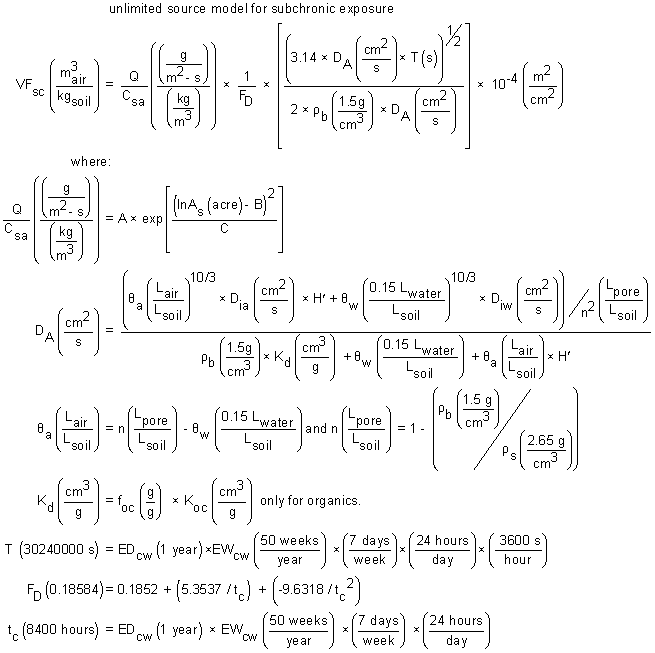
4.13.7 Mass-limit Subchronic Volatilization Factor for Construction Worker (VFsc)
Because the equations developed to calculate SSLs for the inhalation of volatiles outdoors assume an infinite source, they can violate mass-balance considerations, especially for small sources. To address this concern, a mass-limit SSL equation for this pathway may be used (Equation 5-17 of the supplemental soils screening guidance). This equation can be used only when the volume (i.e., area and depth) of the contaminated soil source is known or can be estimated with confidence. As discussed above, the simple site-specific approach for calculating construction scenario SSLs uses the same emission model for volatiles as that used in the residential and non-residential scenarios. However, the conservative nature of this model (i.e., it assumes all contamination is at the surface) makes it sufficiently protective of construction worker exposures to volatiles.

4.13.8 Dermal Contact with Water Supporting Equations
- B = Dimensionless ratio of the permeability coefficient of a compound through the
stratum corneum relative to its permeability coefficient across the viable epidermis (ve)
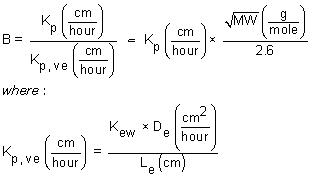
- t* = Time to reach steady-state (hr) = 2.4 τevent

- τevent = Lag time per event (hr/event)

5. Special Considerations
Most of the SLs are readily derived by referring to the above equations. However, there are some cases for which the standard equations do not apply and/or external adjustments to the SLs are recommended. These special case chemicals are discussed below.
5.1 Cadmium
IRIS presents an oral "water" RfD for cadmium for use in assessment of risks to water of 0.0005 mg/kg-day. IRIS also presents an oral "food" RfD for cadmium for use in assessment of risks to soil and biota of 0.001 mg/kg-day. The SLs for Cadmium are based on the appropriate oral RfD based on the media. The "water" RfD is slightly more conservative (by a factor of 2) than the RfD for "food" and it could be argued that the more conservative RfD should be used to develop screening levels. RAGS Part E, in Exhibit 4-1, presents a GIABS for soil of 2.5% and for water of 5%.
5.2 Lead
EPA has no consensus RfD or CSF for inorganic lead, so it is not possible to calculate SLs as we have done for other chemicals. EPA considers lead to be a special case because of the difficulty in identifying the classic "threshold" needed to develop an RfD.
EPA therefore evaluates lead exposure by using blood-lead modeling, such as the Integrated Exposure-Uptake Biokinetic Model (IEUBK). The EPA Office of Solid Waste has also released a detailed directive on risk assessment and cleanup of residential soil lead. The directive recommends that soil lead levels less than 400 mg/kg are generally safe for residential use. Above that level, the document suggests collecting data and modeling blood-lead levels with the IEUBK model. For the purposes of screening, therefore, 400 mg/kg is recommended for residential soils. For water, we suggest 15 µg/L (the EPA Action Level in water), and for air, the National Ambient Air Quality Standard of 0.15 µg/m3.
However, caution should be used when both water and soil are being assessed. The IEUBK model shows that if the average soil concentration is 400 mg/kg, an average tap water concentration above 5 µg/L would yield more than 5% of the population above a 10 µg/dL blood-lead level. If the average tap water concentration is 15 µg/L, an average soil concentration greater than 250 mg/kg would yield more than 5% of the population above a 10 µg/dL blood-lead level.
EPA uses a second Adult Lead Model to estimate SLs for an industrial setting. This SL is intended to protect a fetus that may be carried by a pregnant female worker. It is assumed that a cleanup goal that is protective of a fetus will also afford protection for male or female adult workers. The model equations were developed to calculate cleanup goals such that the fetus of a pregnant female worker would not likely have an unsafe concentration of lead in blood.
For more information on EPA's lead models and other lead-related topics, please go to Addressing Lead at Superfund Sites.
5.3 Manganese
The IRIS RfD (0.14 mg/kg-day) includes manganese from all sources, including diet. The author of the IRIS assessment for manganese recommended that the dietary contribution from the normal U.S. diet (an upper limit of 5 mg/day) be subtracted when evaluating non-food (e.g., drinking water or soil) exposures to manganese, leading to a RfD of 0.071 mg/kg-day for non-food items. The explanatory text in IRIS further recommends using a modifying factor of 3 when calculating risks associated with non-food sources due to a number of uncertainties that are discussed in the IRIS file for manganese, leading to a RfD of 0.024 mg/kg-day. This modified RfD has been used in the derivation of some manganese screening levels for soil and water. For more information regarding the Manganese RfD, users are advised to contact the author of the IRIS assessment on Manganese.
5.4 Vanadium Compounds
The oral RfD toxicity value for Vanadium, used in this website, is derived from the IRIS oral RfD for Vanadium Pentoxide by factoring out the molecular weight (MW) of the oxide ion. Vanadium Pentoxide (V205) has a molecular weight of 181.88. The two atoms of Vanadium contribute 56% of the MW. Vanadium Pentoxide's oral RfD of 9E-03 mg/kg-day multiplied by 56% gives a Vanadium oral RfD of 5.04E-03 mg/kg-day.
5.5 Uranium
"Uranium Soluble Salts" uses the IRIS oral RfD of 3E-03 mg/kg-day. For the insoluble salts of Uranium, the oral RfD of 6E-04 mg/kg-day may be used from the Federal Register, Thursday December 7, 2000. Part II, Environmental Protection Agency. 40 CFR Parts 9, 141, and 142 - National Primary Drinking Water Regulations; Radionuclides; Final Rule. p 76713.
5.6 Chromium (VI)
It is recommended that valence-specific data for chromium be collected when chromium is likely to be an important contaminant at a site, and when hexavalent chromium (Cr (VI)) may exist. For Cr(VI), IRIS shows an air unit risk of 1.2E-2 per (µg/m3). While the exact ratio of Cr(VI) to Cr(III) in the data used to derive the IRIS air unit risk value is not known, it is likely that both Cr(VI) and Cr(III) were present. The RSLs calculated using the IRIS air unit risk assume that the Cr(VI) to Cr(III) ratio is 1:6. Because of various sources of uncertainty, this assumption may overestimate or underestimate the risk calculated. Users are invited to review the document "Toxicological Review of Hexavalent Chromium" in support of the summary information on Cr(VI) on IRIS to determine whether they believe this ratio applies to their projects and to consider consulting with an EPA regional risk assessor.
In the RSL Table, the Cr(VI) specific value (assuming 100% Cr(VI)) is derived by multiplying the IRIS Cr(VI) value by 7. This is considered to be a health-protective assumption, and is also consistent with the State of California's interpretation of the Mancuso study that forms the basis of Cr(VI)'s estimated cancer potency.
If you are working on a chromium site, you may want to contact the appropriate regulatory officials in your region to determine what their position is on this issue.
The Maximum Contaminant Level (MCL) of 100 µg/L for "Chromium (total)", from the EPA's MCL listing is applied to the "Chromium, Total" analyte on this website.
Tier 3 sources were used to derive the screening levels for Cr(VI).
The New Jersey Department of Environmental Protection (NJDEP) determined that Cr(VI) by ingestion is likely to be carcinogenic in humans. NJDEP derived an oral cancer slope factor, based on cancer bioassays conducted by the National Toxicology Program (http://www.state.nj.us/dep/dsr/chromium/soil-cleanup-derivation.pdf). The New Jersey assessment did not make a determination that Cr(VI) was mutagenic by mode of action for carcinogenesis.
EPA's Office of Pesticide Programs (OPP) made a determination that Cr(VI) has a mutagenic mode of action for carcinogenesis in all cells regardless of type, following administration via drinking water. OPP recommended that Age-Dependent Adjustment Factors (ADAFs) be applied when assessing cancer risks from early-life exposure (< 16 years of age). This determination was reviewed by OPP's Cancer Assessment Review Committee and published in a peer review journal).
Therefore, in 2009 the RSL workgroup adopted the Tier III NJDEP values and the OPP recommendation with respect to mutagenicity. More recently, in 2011, external peer reviewers provided input on the EPA's Office of Research and Development Integrated Risk Information System draft Toxicological Review of Hexavalent Chromium (http://cfpub.epa.gov/ncea/iris_drafts/recordisplay.cfm?deid=221433). The majority of reviewers questioned the evidence used to support a mutagenic mode of action for carcinogenesis for Cr(VI). Furthermore, in 2011 California Environmental Protection Agency finalized its drinking water Public Health Goal for Cr(VI). CalEPA's Technical Support Document concluded in numerous studies that Cr(VI) is both genotoxic and mutagenic. (http://www.oehha.ca.gov/water/phg/072911Cr6PHG.html)
Therefore, the RSL workgroup acknowledges that there is uncertainty associated with the assessment of hexavalent chromium. However, no updated consensus IRIS assessment (Tier I) has yet appeared, and chromium is still under review by the IRIS program. With respect to RSLs, the more health-protective approach of applying ADAFs for early life exposure via ingestion, dermal and inhalation was used to calculate screening levels for all exposure pathways. Application of ADAFs for all exposure pathways results in more health-protective screening levels.
As always, consult EPA toxicologists in the Superfund program of the regional office when developing site specific screening levels.
5.7 Aminodinitrotoluenes
The IRIS oral RfD of 2E-03 mg/kg-day for 2,4-Dinitrotoluene is used as a surrogate for 2-Amino-4,6-Dinitrotoluene and 4-Amino-2,6-Dinitrotoluene.
5.8 PCBs
Aroclor 1016 is considered "lowest risk" and assigned appropriate toxicity values. All other Aroclors are assigned the high risk toxicity values.
5.9 Xylenes
The IRIS oral RfD of 2E-01 mg/kg-day for xylene, mixture is used as a surrogate for the 3 xylene congeners. The earlier RfD values for some xylene isomers were withdrawn from our electronic version of HEAST. Also, the IRIS inhalation RfC of 1E-01 mg/m3 for xylene, mixture is used as a surrogate for the 3 xylene congeners.
5.10 Arsenic
Arsenic screening levels for ingestion of soil are now calculated with the relative bioavailability factor (RBA) of 0.6. The RBA can be adjusted using the calculator in site-specific/user-provided mode the same way toxicity values can be changed. The RBA for soil ingestion is shown in the calculator output. The 2012 document, Compilation and Review of Data on Relative Bioavailability of Arsenic in Soil provides supporting information.
Absolute bioavailability can be thought of as the absorption fraction. Relative bioavailability accounts for differences in the bioavailability of a contaminant between the medium of exposure (e.g., soil) and the media associated with the toxicity value (e.g., the arsenic RfD and CSF are derived from drinking water studies). The 60% oral RBA for arsenic in soil is empirically-based. It represents an upper-bound estimate from numerous studies where the oral RBA of soil-borne arsenic in samples collected from across the U.S. was experimentally determined against the water-soluble form. This RBA does not apply to dermal exposures to arsenic in soil for which the absorbed dose is calculated using a dermal absorption fraction (ABSd) of 0.03 (Exhibit 3-4 of USEPA, 2004).
5.11 Total Petroleum Hydrocarbons (TPHs)
The six TPH fractions were assigned representative compounds for determination of toxicity values and chemical-specific parameters to calculate RSLs. The PPRTV paper was the principal source for the derivation of these values.
The carbon ranges and representative compounds are listed in the table below. An average of the chemical-specific parameters for 2-methylnaphthalene and naphthalene was calculated for the medium aromatic fraction.
| TPH Fractions | Number of Carbons | Equivalent Carbon Number Index | Representative Compound (RfD/RfC) |
| Low aliphatic | C5-C8 | EC5-EC8 | n-hexane |
| Medium aliphatic | C9-C18 | EC>8-EC16 | hydrocarbon streams* |
| High aliphatic | C19-C32 | EC>16-EC35 | white mineral oil |
| Low aromatic | C6-C8 | EC6-EC<9 | benzene |
| Medium aromatic | C9-C16 | EC9-EC<22 | 2-methylnaphthalene/naphthalene |
| High aromatic | C17-C32 | EC>22-EC35 | fluoranthene |
*Medium aliphatic representative compound was not listed in PPRTV paper so n-nonane was selected.
5.12 Soil Saturation Limit (Csat)
The soil saturation concentration, Csat, corresponds to the contaminant concentration in soil at which the absorptive limits of the soil particles, the solubility limits of the soil pore water, and saturation of soil pore air have been reached. Above this concentration, the soil contaminant may be present in free phase (i.e., nonaqueous phase liquids (NAPLs) for contaminants that are liquid at ambient soil temperatures and pure solid phases for compounds that are solid at ambient soil temperatures). Csat is not calculated for chemicals that are solid at ambient soil temperatures. The following decision criteria was established from SSL guidance, Table C-3: if melting point is less than 20 °C, chemical is a liquid; if melting point is above 20 °C, chemical is solid.
Equation 4-10 is used to calculate Csat for each volatile contaminant. As an update to RAGS HHEM, Part B (USEPA 1991a), this equation takes into account the amount of contaminant that is in the vapor phase in soil in addition to the amount dissolved in the soil's pore water and sorbed to soil particles.
Chemical-specific Csat concentrations must be compared with each VF-based SL because a basic principle of the SL volatilization model is not applicable when free-phase contaminants are present. How these cases are handled depends on whether the contaminant is liquid or solid at ambient temperatures. Liquid contaminants that have a VF-based SL that exceeds the Csat concentration are set equal to Csat whereas for solids (e.g., PAHs), soil screening decisions are based on the appropriate SLs for other pathways of concern at the site (e.g., ingestion).
The RSL tables and the default calculator settings do not substitute Csat for risk-based calculations. If the risk-based concentration exceeds Csat, the resulting SSL concentration may be overly protective. This is because the dissolved, absorbed and vapor concentrations cease to rise linearly as soil concentration increases above the Csat level (pure product or nonaqueous phase liquid (NAPL) is present). The SSL model used in the RSL calculator is not a four phase model. If a NAPL is present at your site more sophisticated models may be necessary. The calculator, if operated in site-specific mode, will give the option to apply the Csat substitution rule.

5.13 SL Theoretical Ceiling Limit
The ceiling limit of 10+5 mg/kg is equivalent to a chemical representing 10% by weight of the soil sample. At this contaminant concentration (and higher), the assumptions for soil contact may be violated (for example, soil adherence and wind-borne dispersion assumptions) due to the presence of the foreign substance itself.
The RSL tables and the default calculator settings do not substitute the theoretical ceiling limit for risk-based calculations but they do indicate if the resulting RSL has exceeded the theoretical ceiling limit in the key. The calculator, if operated in site-specific mode, will give the option to apply the theoretical ceiling limit.
5.14 Target Risk
With the exceptions described previously, SLs are chemical concentrations that correspond to fixed levels of risk (i.e., either a one-in-one million [10-6] cancer risk or a noncarcinogenic hazard quotient of 1) in soil, air, and water. In most cases, where a substance causes both cancer and noncancer (systemic) effects, the 10-6 cancer risk will result in a more stringent criteria and consequently this value is presented in the printed copy of the Table. SL concentrations that equate to a 10-6 cancer risk are indicated by 'ca' in the calculator and 'c' in the generic tables. SL concentrations that equate to a hazard quotient of 1 for noncarcinogenic concerns are indicated by 'nc' in the calculator and 'n' in the generic tables.
If the SLs are to be used for site screening, it is recommended that both cancer and noncancer-based SLs be used. Both carcinogenic and noncarcinogenic values may be obtained in the Supporting Tables.
Some users of this SL Table may plan to multiply the cancer SL concentrations by 10 or 100 to set 'action levels' for triggering remediation or to set less stringent cleanup levels for a specific site after considering non-risk-based factors such as ambient levels, detection limits, or technological feasibility. This risk management practice recognizes that there may be a range of values that may be 'acceptable' for carcinogenic risk (EPA's risk management range is one-in-a-million [10-6] to one-in-ten thousand [10-4]). However, this practice could lead one to overlook serious noncancer health threats and it is strongly recommended that the user consult with a toxicologist or regional risk assessor before doing this. Carcinogens are indicated by an asterisk ('*') in the SL Table where the noncancer SLs would be exceeded if the cancer value that is displayed is multiplied by 100. ('**') indicate that the noncancer values would be exceeded if the cancer SL were multiplied by 10. There is no range of 'acceptable' noncarcinogenic 'risk' for CERCLA sites. Therefore, the noncancer SLs should not be multiplied by 10 or 100 when setting final cleanup criteria. In the rare case where noncancer SLs are more stringent than cancer SLs set at one-in-one-million risk, a similar approach has been applied (e.g. 'max').
SL concentrations in the printed Table are risk-based, but for soil there are two important exceptions: (1) for several volatile chemicals, SLs may exceed the soil saturation level ('sat') and (2) SLs may exceed a non-risk based 'ceiling limit' concentration of 10+5 mg/kg ('max') for relatively less toxic inorganic and semivolatile contaminants. For more information on the 'sat' value in the SL Table, please see the discussion in Section 5.11. For more information on the 'max' value in the SL Table, please see the discussion in Section 5.13.
With respect to applying a 'ceiling limit' for chemicals other than volatiles, it is recognized that this is not a universally accepted approach. Some within the agency argue that all values should be risk-based to allow for scaling (for example, if the risk-based SL is set at a hazard quotient = 1.0, and the user would like to set the hazard quotient to 0.1 to take into account multiple chemicals, then this is as simple as multiplying the risk-based SL by 1/10th). If scaling is necessary, SL users can do this simply by referring to the Supporting Tables at this website where risk-based soil concentrations are presented for all chemicals.
In spite of the fact that applying a ceiling limit is not a universally accepted approach, this table applies a 'max' soil concentration to the SL Table for the following reasons:
Risk-based SLs for some chemicals in soil exceed unity (>1,000,000 mg/kg), which is not possible.
The ceiling limit of 10+5 mg/kg is equivalent to a chemical representing 10% by weight of the soil sample. At this contaminant concentration (and higher), the assumptions for soil contact may be violated (for example, soil adherence and wind-borne dispersion assumptions) due to the presence of the foreign substance itself.
SLs currently do not address short-term exposures (e.g., pica children and construction workers). Although extremely high soil SLs are likely to represent relatively non-toxic chemicals, such high values may not be justified if in fact more toxicological data were available for evaluating short-term and/or acute exposures.
5.15 Screening Sites with Multiple Contaminants
The screening levels in the tables are calculated under the assumption that only one contaminant is present. Users needing to screen sites with multiple contaminants should consult with their regional risk assessors. The following sections describe how target risks can be changed to screen against multiple contaminants and how the ratio of concentration to RSL can be used to estimate total risk.
5.15.1 Adjusting Target Risk and Target Hazard Quotient
When multiple contaminants are present at a site the target hazard quotient (THQ) may be modified. The following options are among the commonly used methods to modify the THQ:
The calculator on this website can be used to generate SLs based on any THQ or target cancer risk (TR) deemed appropriate by the user. The THQ input to the calculator can be modified from the default of 1. How much it should be modified is a user decision, but it could be based upon the number of contaminants being screened together. For example, if one is screening two contaminants together, then the THQ could be modified to 0.5. If ten contaminants are being screened together, then the THQ could be modified to 0.1. The above example weights each chemical equally; it is also possible to weight the chemicals unequally, as long as the total risk meets the desired goal. The decision of how to weight the chemicals is likely to be site-specific, and it is recommended that this decision be made in consultation with the regional risk assessor.
Note that when the TR or THQ is altered, the relationship between cancer-based and noncancer-based SLs may change. At certain risk levels, the cancer-based number may be more conservative; at different risk levels, the noncancer-based number may be more conservative. The data user needs to consider both cancer and noncancer endpoints.
Similar to the above approach of using the calculator to recalculate SLs based on non-default target levels, the values in the screening tables themselves can be addressed directly. Consistent with the above logic, although the EPA Superfund Program has not developed guidance on this, it is not uncommon that Superfund sites are screened at a THQ of 0.1. (The cancer-based SLs are already at a target risk of 1E-6 and are usually not adjusted further in this scenario.) SLs based on a THQ of 0.1 can be derived by dividing a default SL by 10. Again, note that altering the target HQ can change the relationship between cancer-based and noncancer-based screening levels; the data user needs to consider both endpoints. Additional approaches or alternatives may exist. When screening actual or potential Superfund sites, users are encouraged to consult with risk assessors in that EPA Regional Office when evaluating or screening contamination at a site with multiple contaminants to see if they may know of another approach or if they have a preference.
5.15.2 Using RSLs to Sum Risk from Multiple Contaminants
RSLs can be used to estimate the total risk from multiple contaminants at a site as part of a screening procedure used by some regions. This methodology, which does not substitute for a baseline risk assessment, is often called the "sum of the ratios" approach. A step-wise approach follows:
Perform an extensive records search and compile existing data.
Identify site contaminants in the SL Table. Record the SL concentrations for various media and note whether SL is based on cancer risk (indicated by 'c') or noncancer hazard (indicated by 'n'). Segregate cancer SLs from non-cancer SLs and exclude (but don't eliminate) non-risk based SLs 's' or 'm'.
For cancer risk estimates, take the site-specific concentration (maximum or 95th percent of the upper confidence limit on the mean (UCL)) and divide by the SL concentrations that are designated for cancer evaluation 'c'. Multiply this ratio by 10-6 to estimate chemical-specific risk for a reasonable maximum exposure (RME). For multiple pollutants, simply add the risk for each chemical. See equation below.
For non-cancer hazard estimates, divide the concentration term by its respective non-cancer SL designated as 'n' and sum the ratios for multiple contaminants. The cumulative ratio represents a non-carcinogenic hazard index (HI). A hazard index of 1 or less is generally considered 'safe'. A ratio greater than 1 suggests further evaluation. Note that carcinogens may also have an associated non-cancer SL that is not listed in the SL Table. To obtain these values, the user should view the Supporting Tables. See equation below.


5.16 Deriving Soil Gas SLs
The air SLs could apply to indoor air from, e.g., a vapor intrusion scenario. To model indoor air concentrations from other media (e.g., soil gas, groundwater), consult with regional experts in vapor intrusion.
For more information on EPA's current understanding of this emerging exposure pathway, please refer to EPA's recent draft guidance Evaluating the Vapor Intrusion to Indoor Air Pathway from Groundwater and Soils (Subsurface Vapor Intrusion Guidance) (USEPA 2002) available on the web at: https://www.epa.gov/osw/hazard/correctiveaction/eis/vapor.htm.
5.17 Mutagens
Some of the cancer causing analytes in this tool operate by a mutagenic mode of action for carcinogenesis. There is reason to surmise that some chemicals with a mutagenic mode of action, which would be expected to cause irreversible changes to DNA, would exhibit a greater effect in early-life versus later-life exposure. Cancer risk to children in the context of the U.S. Environmental Protection Agency's cancer guidelines (U.S. EPA, 2005) includes both early-life exposures that may result in the occurrence of cancer during childhood and early-life exposures that may contribute to cancers later in life. In keeping with this guidance, separate cancer risk equations are presented for mutagens. The mutagen vinyl chloride has a unique set of equations. Consult Supplemental Guidance for Assessing Susceptibility from Early-Life Exposure to Carcinogens, EPA/630/R-03/003F, March 2005 for further information.
https://www.epa.gov/oswer/riskassessment/sghandbook/chemicals.htm provides more detailed information about which contaminants are considered carcinogenic by a mutagenic mode of action. In addition to the previous document's list of these contaminants, Chromium VI, 7,12-Dimethylbenz(a)anthracene, Benz(a)anthracene, Benzo(b)fluoranthene, Benzo(k)fluoranthene, Chrysene and Indeno(1,2,3-c,d)pyrene are also considered carcinogenic by a mutagenic mode of action.
5.18 Trichloroethylene (TCE)
It is recommended that a regional risk assessor be consulted when evaluating TCE in any medium especially when less than chronic exposure scenarios are considered. The Superfund program issued a Compilation of Information Relating of Early/Interim Actions at Superfund Sites and the TCE IRIS Assessment memo in August 2014. Several regions have issued their own guidance as well.
In order to make the calculator display the correct results for TCE, the standard cancer and mutagen equations needed to be combined. Since TCE requires the use of different toxicity values for cancer and mutagen equations, it was decided to make a toxicity value adjustment factor for cancer (CAF) and mutagens (MAF). The adjustments were done for oral (o) and inhalation (i). These adjustment factors are used in the TCE equation images presented in section 4. The equations used are presented below. The adjustment factors are based on the adult-based toxicity values and these are the cancer toxicity values presented in the Generic Tables.
5.19 Mercuric Chloride (and other Mercury salts)
The IRIS RfC for "Mercury (elemental)" is used as a surrogate for "Mercuric Chloride (and other Mercury salts)". Note, that the VF for "Mercury (elemental)" is not used as a surrogate for "Mercuric Chloride (and other Mercury salts)". The use of the surrogate RfC would appear to be a violation of the RSL toxicity hierarchy because Cal EPA offers a RfC for Mercuric Chloride. However, the actual form of mercury evaluated for the Cal EPA RfC was elemental mercury. Since IRIS already had a RfC for "Mercury (elemental)", it was decided to use the tier 1 source over a tier 3 source.
5.20 Cyanide (CN-)
The IRIS RfC for "Hydrogen Cyanide" is used as a surrogate for "Cyanide (CN-)".
6. Using the Calculator
The Calculator can be used to generate site-specific SLs or PRGs. The calculator requires the user to make some simple selections. To use the calculator Select a land use. Next, select whether you want Default or Site-specific SLs. Selecting default screening levels will reproduce the results in the generic Generic Tables. Selecting Site-Specific will allow you to change exposure parameters. Now pick your analytes. To pick several in a row, depress the left mouse button and drag, then release. Or hold the Ctrl key down and select multiple analytes that are not in a row. Select the output option. Hit the retrieve button. If you selected Site-Specific, the next page allows you to change exposure parameters. Hit the retrieve button. SLs are being calculated. The first table presents the input parameters that were selected. The next table contains the screening levels. This table can be too big to print. The easiest way to manage this table is to move it to a spreadsheet or a database. To copy this table, hold the left mouse key down and drag across the entire table. when done, press Ctrl c to copy. Switch to a spreadsheet and press Ctrl v to paste.
Table 1. Standard Default Factors
| Symbol | Definition (units) | Default | Reference |
SLs |
|||
| SLres-air-ca | Resident Air Carcinogenic (µg/m3) | Contaminant-specific | Determined in this calculator |
| SLres-air-ca-vinyl chloride | Resident Air Carcinogenic Vinyl Chloride (µg/m3) | Vinyl Chloride-specific | Determined in this calculator |
| SLres-air-mu | Resident Air Mutagenic (µg/m3) | Mutagen-specific | Determined in this calculator |
| SLres-air-nc | Resident Air Noncarcinogenic (µg/m3) | Contaminant-specific | Determined in this calculator |
| SLres-fsh-ca-ing | Resident Fish Carcinogenic (mg/kg) | Contaminant-specific | Determined in this calculator |
| SLres-fsh-nc-ing | Resident Fish Noncarcinogenic (mg/kg) | Contaminant-specific | Determined in this calculator |
| SLwater-ca-ing | Resident Tapwater Groundwater Carcinogenic Ingestion (µg/L) | Contaminant-specific | Determined in this calculator |
| SLwater-ca-der | Resident Tapwater Groundwater Carcinogenic Dermal (µg/L) | Contaminant-specific | Determined in this calculator |
| SLwater-ca-inh | Resident Tapwater Groundwater Carcinogenic Inhalation (µg/L) | Contaminant-specific | Determined in this calculator |
| SLwater-ca-tot | Resident Tapwater Groundwater Carcinogenic Total (µg/L) | Contaminant-specific | Determined in this calculator |
| SLres-water-ca-vc-ing | Resident Tapwater Groundwater Carcinogenic Vinyl Chloride Ingestion (µg/L) | Contaminant-specific | Determined in this calculator |
| SLres-water-ca-vc-der | Resident Tapwater Groundwater Carcinogenic Vinyl Chloride Dermal (µg/L) | Contaminant-specific | Determined in this calculator |
| SLres-water-ca-vc-inh | Resident Tapwater Groundwater Carcinogenic Vinyl Chloride Inhalation (µg/L) | Contaminant-specific | Determined in this calculator |
| SLres-water-ca-vc-tot | Resident Tapwater Groundwater Carcinogenic Vinyl Chloride Total (µg/L) | Contaminant-specific | Determined in this calculator |
| SLwater-mu-ing | Resident Tapwater Groundwater Mutagenic Ingestion (µg/L) | Contaminant-specific | Determined in this calculator |
| SLwater-mu-der | Resident Tapwater Groundwater Mutagenic Dermal (µg/L) | Contaminant-specific | Determined in this calculator |
| SLwater-mu-inh | Resident Tapwater Groundwater Mutagenic Inhalation (µg/L) | Mutagen-specific | Determined in this calculator |
| SLwater-mu-tot | Resident Tapwater Groundwater Mutagenic Total (µg/L) | Contaminant-specific | Determined in this calculator |
| SLwater-nc-ing | Resident Tapwater Groundwater Noncarcinogenic Ingestion (µg/L) | Contaminant-specific | Determined in this calculator |
| SLwater-nc-der | Resident Tapwater Groundwater Noncarcinogenic Dermal (µg/L) | Contaminant-specific | Determined in this calculator |
| SLwater-nc-inh | Resident Tapwater Groundwater Noncarcinogenic Inhalation (µg/L) | Mutagen-specific | Determined in this calculator |
| SLwater-nc-tot | Resident Tapwater Groundwater Noncarcinogenic Total (µg/L) | Contaminant-specific | Determined in this calculator |
| SLres-sol-ca-ing | Resident Soil Carcinogenic Ingestion (mg/kg) | Contaminant-specific | Determined in this calculator |
| SLres-sol-ca-der | Resident Soil Carcinogenic Dermal (mg/kg) | Contaminant-specific | Determined in this calculator |
| SLres-sol-ca-inh | Resident Soil Carcinogenic Inhalation (mg/kg) | Contaminant-specific | Determined in this calculator |
| SLres-sol-ca-tot | Resident Soil Carcinogenic Total (mg/kg) | Contaminant-specific | Determined in this calculator |
| SLres-sol-ca-vc-ing | Resident Soil Carcinogenic Vinyl Chloride Ingestion (mg/kg) | Vinyl Chloride -specific | Determined in this calculator |
| SLres-sol-ca-vc-der | Resident Soil Carcinogenic Vinyl Chloride Dermal (mg/kg) | Vinyl Chloride-specific | Determined in this calculator |
| SLres-sol-ca-vc-inh | Resident Soil Carcinogenic Vinyl Chloride Inhalation (mg/kg) | Vinyl Chloride-specific | Determined in this calculator |
| SLres-sol-ca-vc-tot | Resident Soil Carcinogenic Vinyl Chloride Total (mg/kg) | Vinyl Chloride-specific | Determined in this calculator |
| SLres-sol-mu-ing | Resident Soil Mutagenic Ingestion (mg/kg) | Mutagen-specific | Determined in this calculator |
| SLres-sol-mu-der | Resident Soil Mutagenic Dermal (mg/kg) | Mutagen-specific | Determined in this calculator |
| SLres-sol-mu-inh | Resident Soil Mutagenic Inhalation (mg/kg) | Mutagen-specific | Determined in this calculator |
| SLres-sol-mu-tot | Resident Soil Mutagenic Total (mg/kg) | Mutagen-specific | Determined in this calculator |
| SLres-sol-nc-ing | Resident Soil Noncarcinogenic Ingestion (mg/kg) | Contaminant-specific | Determined in this calculator |
| SLres-sol-nc-der | Resident Soil Noncarcinogenic Dermal (mg/kg) | Contaminant-specific | Determined in this calculator |
| SLres-sol-nc-inh | Resident Soil Noncarcinogenic Inhalation (mg/kg) | Contaminant-specific | Determined in this calculator |
| SLres-sol-nc-tot | Resident Soil Noncarcinogenic Total (mg/kg) | Contaminant-specific | Determined in this calculator |
| SLw-sol-ca-ing | Composite Worker Soil Carcinogenic Ingestion (mg/kg) | Contaminant-specific | Determined in this calculator |
| SLw-sol-ca-der | Composite Worker Soil Carcinogenic Dermal (mg/kg) | Contaminant-specific | Determined in this calculator |
| SLw-sol-ca-inh | Composite Worker Soil Carcinogenic Inhalation (mg/kg) | Contaminant-specific | Determined in this calculator |
| SLw-sol-ca-tot | Composite Worker Soil Carcinogenic Total (mg/kg) | Contaminant-specific | Determined in this calculator |
| SLw-sol-nc-ing | Composite Worker Soil Noncarcinogenic Ingestion (mg/kg) | Contaminant-specific | Determined in this calculator |
| SLw-sol-nc-der | Composite Worker Soil Noncarcinogenic Dermal (mg/kg) | Contaminant-specific | Determined in this calculator |
| SLw-sol-nc-inh | Composite Worker Soil Noncarcinogenic Inhalation (mg/kg) | Contaminant-specific | Determined in this calculator |
| SLw-sol-nc-tot | Composite Worker Soil Noncarcinogenic Total (mg/kg) | Contaminant-specific | Determined in this calculator |
| SLiw-sol-ca-ing | Indoor Worker Soil Carcinogenic Ingestion (mg/kg) | Contaminant-specific | Determined in this calculator |
| SLiw-sol-ca-der | Indoor Worker Soil Carcinogenic Dermal (mg/kg) | Contaminant-specific | Determined in this calculator |
| SLiw-sol-ca-inh | Indoor Worker Soil Carcinogenic Inhalation (mg/kg) | Contaminant-specific | Determined in this calculator |
| SLiw-sol-ca-tot | Indoor Worker Soil Carcinogenic Total (mg/kg) | Contaminant-specific | Determined in this calculator |
| SLiw-sol-nc-ing | Indoor Worker Soil Noncarcinogenic Ingestion (mg/kg) | Contaminant-specific | Determined in this calculator |
| SLiw-sol-nc-der | Indoor Worker Soil Noncarcinogenic Dermal (mg/kg) | Contaminant-specific | Determined in this calculator |
| SLiw-sol-nc-inh | Indoor Worker Soil Noncarcinogenic Inhalation (mg/kg) | Contaminant-specific | Determined in this calculator |
| SLiw-sol-nc-tot | Indoor Worker Soil Noncarcinogenic Total (mg/kg) | Contaminant-specific | Determined in this calculator |
| SLow-sol-ca-ing | Outdoor Worker Soil Carcinogenic Ingestion (mg/kg) | Contaminant-specific | Determined in this calculator |
| SLow-sol-ca-der | Outdoor Worker Soil Carcinogenic Dermal (mg/kg) | Contaminant-specific | Determined in this calculator |
| SLow-sol-ca-inh | Outdoor Worker Soil Carcinogenic Inhalation (mg/kg) | Contaminant-specific | Determined in this calculator |
| SLow-sol-ca-tot | Outdoor Worker Soil Carcinogenic Total (mg/kg) | Contaminant-specific | Determined in this calculator |
| SLow-sol-nc-ing | Outdoor Worker Soil Noncarcinogenic Ingestion (mg/kg) | Contaminant-specific | Determined in this calculator |
| SLow-sol-nc-der | Outdoor Worker Soil Noncarcinogenic Dermal (mg/kg) | Contaminant-specific | Determined in this calculator |
| SLow-sol-nc-inh | Outdoor Worker Soil Noncarcinogenic Inhalation (mg/kg) | Contaminant-specific | Determined in this calculator |
| SLow-sol-nc-tot | Outdoor Worker Soil Noncarcinogenic Total (mg/kg) | Contaminant-specific | Determined in this calculator |
| SLcw-sol-ca-ing | Construction Worker Soil Carcinogenic Ingestion (mg/kg) | Contaminant-specific | Determined in this calculator |
| SLcw-sol-ca-der | Construction Worker Soil Carcinogenic Dermal (mg/kg) | Contaminant-specific | Determined in this calculator |
| SLcw-sol-ca-inh | Construction Worker Soil Carcinogenic Inhalation (mg/kg) | Contaminant-specific | Determined in this calculator |
| SLcw-sol-ca-tot | Construction Worker Soil Carcinogenic Total (mg/kg) | Contaminant-specific | Determined in this calculator |
| SLcw-sol-nc-ing | Construction Worker Soil Noncarcinogenic Ingestion (mg/kg) | Contaminant-specific | Determined in this calculator |
| SLcw-sol-nc-der | Construction Worker Soil Noncarcinogenic Dermal (mg/kg) | Contaminant-specific | Determined in this calculator |
| SLcw-sol-nc-inh | Construction Worker Soil Noncarcinogenic Inhalation (mg/kg) | Contaminant-specific | Determined in this calculator |
| SLcw-sol-nc-tot | Construction Worker Soil Noncarcinogenic Total (mg/kg) | Contaminant-specific | Determined in this calculator |
| SLrec-sol-ca-ing | Recreator Soil Carcinogenic Ingestion (mg/kg) | Contaminant-specific | Determined in this calculator |
| SLrec-sol-ca-der | Recreator Soil Carcinogenic Dermal (mg/kg) | Contaminant-specific | Determined in this calculator |
| SLrec-sol-ca-inh | Recreator Soil Carcinogenic Inhalation (mg/kg) | Contaminant-specific | Determined in this calculator |
| SLrec-sol-ca-tot | Recreator Soil Carcinogenic Total (mg/kg) | Contaminant-specific | Determined in this calculator |
| SLrec-sol-nc-ing | Recreator Soil Noncarcinogenic Ingestion (mg/kg) | Contaminant-specific | Determined in this calculator |
| SLrec-sol-nc-der | Recreator Soil Noncarcinogenic Dermal (mg/kg) | Contaminant-specific | Determined in this calculator |
| SLrec-sol-nc-inh | Recreator Soil Noncarcinogenic Inhalation (mg/kg) | Contaminant-specific | Determined in this calculator |
| SLrec-sol-nc-tot | Recreator Soil Noncarcinogenic Total (mg/kg) | Contaminant-specific | Determined in this calculator |
| SLrec-water-ca-der | Recreator Surface Water Carcinogenic Dermal (µg/L) | Contaminant-specific | Determined in this calculator |
| SLrec-water-ca-ing | Recreator Surface Water Carcinogenic Ingestion (µg/L) | Contaminant-specific | Determined in this calculator |
| SLrec-water-ca-tot | Recreator Surface Water Carcinogenic Total (µg/L) | Contaminant-specific | Determined in this calculator |
| SLrec-water-vc-der | Recreator Surface Water Carcinogenic Vinyl Chloride Dermal (µg/L) | Contaminant-specific | Determined in this calculator |
| SLrec-water-vc-ing | Recreator Surface Water Carcinogenic Vinyl Chloride Ingestion (µg/L) | Contaminant-specific | Determined in this calculator |
| SLrec-water-vc-tot | Recreator Surface Water Carcinogenic Vinyl Chloride Total (µg/L) | Contaminant-specific | Determined in this calculator |
| SLrec-water-nc-der | Recreator Surface Water Non-Carcinogenic Dermal (µg/L) | Contaminant-specific | Determined in this calculator |
| SLrec-water-nc-ing | Recreator Surface Water Non-Carcinogenic Ingestion (µg/L) | Contaminant-specific | Determined in this calculator |
| SLrec-water-nc-tot | Recreator Surface Water Non-Carcinogenic Total (µg/L) | Contaminant-specific | Determined in this calculator |
Toxicity Values |
|||
| RfDo | Chronic Oral Reference Dose (mg/kg-day) | Contaminant-specific | EPA Superfund hierarchy |
| RfC | Chronic Inhalation Reference Concentration (mg/m3) | Contaminant-specific | EPA Superfund hierarchy |
| CSFo | Chronic oral Slope Factor (mg/kg-day)-1 | Contaminant-specific | EPA Superfund hierarchy |
| IUR | Chronic Inhalation Unit Risk (µg/m3)-1 | Contaminant-specific | EPA Superfund hierarchy |
Miscellaneous Variables |
|||
| TR | target risk | 1 |
Determined in this calculator |
| THQ | target hazard quotient | 1 | Determined in this calculator |
| K | Andelman Volatilization Factor (L/m3) | 0.5 | U.S. EPA 1991b (pg. 20) |
| Kp | Dermal Permeability Constant (cm/hr) | Contaminant-specific | U.S. EPA 2004 |
| ATressc | Averaging time - resident soil child (days) | 365 x EDressc = 2190 | U.S. EPA 1989 (pg. 6-23) |
| ATressa | Averaging time - resident soil adult (days) | 365 x EDress = 9490 | U.S. EPA 1989 (pg. 6-23) |
| ATress | Averaging time - resident soil age adjusted (days) | 365 x LT = 25550 | U.S. EPA 1989 (pg. 6-23) |
| ATreswc | Averaging time - resident tapwater child (days) | 365 x EDreswc = 2190 | U.S. EPA 1989 (pg. 6-23) |
| ATreswa | Averaging time - resident tapwater adult (days) | 365 x EDresw = 9490 | U.S. EPA 1989 (pg. 6-23) |
| ATresw | Averaging time - resident tapwater age adjusted (days) | 365 x LT = 25550 | U.S. EPA 1989 (pg. 6-23) |
| ATresfa | Averaging time - resident fish adult non-carcinogenic (days) | 365 x EDresf = 9490 | U.S. EPA 1989 (pg. 6-23) |
| ATresf | Averaging time - resident fish adult carcinogenic (days) | 365 x LT = 25550 | U.S. EPA 1989 (pg. 6-23) |
| ATresaa | Averaging time - resident air adult non-carcinogenic (days) | 365 x EDresa = 9490 | U.S. EPA 1989 (pg. 6-23) |
| ATresa | Averaging time - resident air adult carcinogenic (days) | 365 x LT = 25550 | U.S. EPA 1989 (pg. 6-23) |
| ATw | Averaging time - composite worker (days) | 365 x EDw = 9125 (non-carcinogenic) 365 x LT = 25550 (carcinogenic) |
U.S. EPA 1989 (pg. 6-23) |
| ATiw | Averaging time - indoor worker soil (days) | 365 x EDiw = 9125 (non-carcinogenic) 365 x LT = 25550 (carcinogenic) |
U.S. EPA 1989 (pg. 6-23) |
| ATow | Averaging time - outdoor worker soil (days) | 365 x EDow = 9125 (non-carcinogenic) 365 x LT = 25550 (carcinogenic) |
U.S. EPA 1989 (pg. 6-23) |
| ATcw | Averaging time - construction worker soil (days) | EWcw x 7 (d/wk) x EDcw = 350 (non-carcinogenic) 365 x LT = 25550 (carcinogenic) |
U.S. EPA 1989 (pg. 6-23) |
| ATrecsc | Averaging time - recreator soil child (days) | 365 x EDrecsc | U.S. EPA 1989 (pg. 6-23) |
| ATrecsa | Averaging time - recreator soil adult (days) | 365 x EDrecsa | U.S. EPA 1989 (pg. 6-23) |
| ATrecs | Averaging time - recreator soil (days) | 365 x EDrecs | U.S. EPA 1989 (pg. 6-23) |
| ATrecwc | Averaging time - recreator surface water child (days) | 365 x EDrecwc | U.S. EPA 1989 (pg. 6-23) |
| ATrecwa | Averaging time - recreator surface water adult (days) | 365 x EDrecwa | U.S. EPA 1989 (pg. 6-23) |
| ATrecw | Averaging time - recreator surface water (days) | 365 x EDrecw | U.S. EPA 1989 (pg. 6-23) |
| LT | Lifetime (years) | 70 | U.S. EPA 1989 (pg. 6-22) |
Ingestion and Dermal Contact Rates |
|||
| IRWreswc | Resident Drinking Water Ingestion Rate - Child (L/day) | 0.78 | U.S. EPA 2011, Tables 3-15 and 3-33; weighted average of 90th percentile consumer-only ingestion of drinking water (birth to <6 years) |
| IRWreswa | Resident Drinking Water Ingestion Rate - Adult (L/day) | 2.5 | U.S. EPA 2011, Table 3-33; 90th percentile of consumer-only ingestion of drinking water (>= 21 years) |
| IFWres-adj | Resident Drinking Water Ingestion Rate - Age-adjusted (L/kg) | 327.95 | Calculated using the age adjusted intake factors equation |
| IFWMres-adj | Resident Mutagenic Drinking Water Ingestion Rate - Age-adjusted (L/kg) | 1019.9 | Calculated using the age adjusted intake factors equation |
| IRSressc | Resident Soil Ingestion Rate - Child (mg/day) | 200 | U.S. EPA 1991a (pg. 15) |
| IRSressa | Resident Soil Ingestion Rate - Adult (mg/day) | 100 | U.S. EPA 1991a (pg. 15) |
| IFSres-adj | Resident Soil Ingestion Rate - Age-adjusted (mg/kg) | 36750 | Calculated using the age adjusted intake factors equation |
| IFSMres-adj | Resident Mutagenic Soil Ingestion Rate - Age-adjusted (mg/kg) | 166833.33 | Calculated using the age adjusted intake factors equation |
| IRiw | Indoor Worker Soil Ingestion Rate (mg/day) | 50 | U.S. EPA 1991a (pg. 15) |
| IRow | Outdoor Worker Soil Ingestion Rate (mg/day) | 100 | U.S. EPA 1991a (pg. 15) |
| IRcw | Construction Worker Soil Ingestion Rate (mg/day) | 330 | U.S. EPA 2002 Exhibit 5-1 |
| IRWrecwc | Recreator Surface Water Ingestion Rate - Child (L/hr) | 0.05 | U.S. EPA Region 4 |
| IRWrecwa | Recreator Surface Water Ingestion Rate - Adult (L/hr) | 0.05 | U.S. EPA Region 4 |
| IFWrec-adj | Recreator Surface Water Ingestion Rate - Age-adjusted (L/kg) | Site-specific | Calculated using the age adjusted intake factors equation |
| IRW0-2 | Surface Water Ingestion Rate - Age Segment 0-2 (L/hr) | 0.05 | U.S. EPA Region 4 |
| IRW2-6 | Surface Water Ingestion Rate - Age Segment 2-6 (L/hr) | 0.05 | U.S. EPA Region 4 |
| IRW6-16 | Surface Water Ingestion Rate - Age Segment 6-16 (L/hr) | 0.05 | U.S. EPA Region 4 |
| IRW16-26 | Surface Water Ingestion Rate - Age Segment 16-26 (L/hr) | 0.05 | U.S. EPA Region 4 |
| IFWMrec-adj | Recreator Mutagenic Surface Water Ingestion Rate - Age-adjusted (L/kg) | Site-specific | Calculated using the age adjusted intake factors equation |
| IRSrecsc | Recreator Soil Ingestion Rate - Child (mg/day) | 200 | U.S. EPA 1991a (pg. 15) |
| IRSrecsa | Recreator Soil Ingestion Rate - Adult (mg/day) | 100 | U.S. EPA 1991a (pg. 15) |
| IFSrec-adj | Recreator Soil Ingestion Rate - Age-adjusted (mg/kg) | Site-specific | Calculated using the age adjusted intake factors equation |
| IRS0-2 | Soil Ingestion Rate - Age-segment 0-2 (mg/day) | 200 | U.S. EPA 1991a (pg. 15) |
| IRS2-6 | Soil Ingestion Rate - Age-segment 2-6 (mg/day) | 200 | U.S. EPA 1991a (pg. 15) |
| IRS6-16 | Soil Ingestion Rate - Age-segment 6-16 (mg/day) | 100 | U.S. EPA 1991a (pg. 15) |
| IRS16-26 | Soil Ingestion Rate - Age-segment 16-26 (mg/day) | 100 | U.S. EPA 1991a (pg. 15) |
| IFSMrec-adj | Recreator Mutagenic Soil Ingestion Rate - Age-adjusted (mg/kg) | Site-specific | Calculated using the age adjusted intake factors equation |
| DFSres-adj | Resident soil dermal contact factor- age-adjusted (mg/kg) | 112266 | Calculated using the age adjusted intake factors equation |
| DFSMres-adj | Resident Mutagenic soil dermal contact factor- age-adjusted (mg/kg) | 475598.66 | Calculated using the age adjusted intake factors equation |
| DFSrec-adj | Recreator soil dermal contact factor- age-adjusted (mg/kg) | Site-specific | Calculated using the age adjusted intake factors equation |
| DFSMrec-adj | Recreator Mutagenic soil dermal contact factor- age-adjusted (mg/kg) | Site-specific | Calculated using the age adjusted intake factors equation |
| DFWres-adj | Resident water dermal contact factor- age-adjusted (cm2 - event/kg) | 2721670 | Calculated using the age adjusted intake factors equation |
| DFWMres-adj | Resident Mutagenic water dermal contact factor- age-adjusted (cm2 - event/kg) | Site-specific | Calculated using the age adjusted intake factors equation |
| DFWrec-adj | Recreator water dermal contact factor- age-adjusted (cm2 - event/kg) | Site-specific | Calculated using the age adjusted intake factors equation |
| DFWMrec-adj | Recreator Mutagenic water dermal contact factor- age-adjusted (cm2 - event/kg) | Site-specific | Calculated using the age adjusted intake factors equation |
| IRFresfa | Fish Ingestion Rate (mg/day) | Site-specific | Recommend using site-specific values |
| SAressc | Resident soil surface area - child (cm2) | 2373 | U.S. EPA 2011a, Tables 7-2 and 7-8; weighted average of mean values for head, hands, forearms, lower legs, and feet (male and female, birth to < 6 years)(forearm and lower leg-specific data used when available, ratios for nearest available age group used elsewhere) |
| SAressa | Resident soil surface area - adult (cm2) | 6032 | U.S. EPA 2011, Tables 7-2 and 7-12; weighted average of mean values for head, hands, forearms, lower legs, and feet (male and female, 21+ years)(forearm and lower leg-specific data used for males and female lower leg; ratio of male forearm to arm applied to female arm data. |
| SAreswc | Resident water surface area - child (cm2) | 6378 | U.S. EPA 2011, Table 7.10; weighted average of mean values for children <6 years. |
| SAreswa | Resident water surface area - adult (cm2) | 20900 | U.S. EPA 2011, Table 7.10; weighted average of mean values for adults, male and female 21+. |
| SAow | Worker soil surface area - adult (cm2) | 3527 | US EPA 2011a, Table 7-2; weighted average of mean values for head, hands, and forearms (male and female, 21+years) |
| SAcw | Worker soil surface area - adult (cm2) | 3527 | US EPA 2011a, Table 7-2; weighted average of mean values for head, hands, and forearms (male and female, 21+years) |
| SArecsc | Recreator surface area - child soil (cm2) | Site-specific | Calculated using the age adjusted intake factors equation |
| SArecsa | Recreator surface area - adult soil (cm2) | Site-specific | Calculated using the age adjusted intake factors equation |
| SArecwc | Recreator surface area - child water (cm2) | Site-specific | Calculated using the age adjusted intake factors equation |
| SArecwa | Recreator surface area - adult water (cm2) | Site-specific | Calculated using the age adjusted intake factors equation |
| SA0-2 | Recreator soil surface area - age segment 0-2 (cm2) | Site-specific | Site-specific |
| SA2-6 | Recreator soil surface area - age segment 2-6 (cm2) | Site-specific | Site-specific |
| SA6-16 | Recreator soil surface area - age segment 6-16 (cm2) | Site-specific | Site-specific |
| SA16-26 | Recreator soil surface area - age segment 16-26 (cm2) | Site-specific | Site-specific |
| AFressc | Resident soil adherence factor - child (mg/cm2) | 0.2 | U.S. EPA 2002 (Exhibit 1-2) |
| AFressa | Resident soil adherence factor - adult (mg/cm2) | 0.07 | U.S. EPA 2002 (Exhibit 1-2) |
| AFow | Worker soil adherence factor (mg/cm2) | 0.12 | U.S. EPA 2011, Table 7-20 and Section 7.2.2; arithmetic mean of weighted average of body part- specific (hands, forearms, and face) mean adherence factors for adult commercial/industrial activities |
| AFcw | Construction Worker soil adherence factor (mg/cm2) | 0.3 | U.S. EPA 2002 (Exhibit 5-1) |
| AFrecsc | Recreator soil adherence factor - child (mg/cm2) | Site-specific | Site-specific |
| AFrecsa | Recreator soil adherence factor - adult (mg/cm2) | Site-specific | Site-specific |
| AF0-2 | Recreator soil adherence factor - age segment 0-2 (mg/cm2) | Site-specific | Site-specific |
| AF2-6 | Recreator soil adherence factor - age segment 2-6 (mg/cm2) | Site-specific | Site-specific |
| AF6-16 | Recreator soil adherence factor - age segment 6-16 (mg/cm2) | Site-specific | Site-specific |
| AF16-26 | Recreator soil adherence factor - age segment 16-26 (mg/cm2) | Site-specific | Site-specific |
| BWressc | Resident Body Weight - soil child (kg) | 15 | U.S. EPA 1991a (pg. 15) |
| BWressa | Resident Body Weight - soil adult (kg) | 80 | U.S. EPA 2011, Table 8-3; weighted mean values for adults 21 - 78 |
| BWreswc | Resident Body Weight - water child (kg) | 15 | U.S. EPA 1991a (pg. 15) |
| BWreswa | Resident Body Weight - water adult (kg) | 80 | U.S. EPA 2011, Table 8-3; weighted mean values for adults 21 - 78 |
| BWrecsc | Recreator Body Weight - child soil (kg) | Site-specific | Site-specific |
| BWrecsa | Recreator Body Weight - adult soil (kg) | Site-specific | Site-specific |
| BWrecwc | Recreator Body Weight - child water (kg) | Site-specific | Site-specific |
| BWrecwa | Recreator Body Weight - adult water (kg) | Site-specific | Site-specific |
| BW0-2 | Recreator Body Weight - age segment 0-2 (kg) | Site-specific | Site-specific |
| BW2-6 | Recreator Body Weight - age segment 2-6 (kg) | Site-specific | Site-specific |
| BW6-16 | Recreator Body Weight - age segment 6-16 (kg) | Site-specific | Site-specific |
| BW16-26 | Recreator Body Weight - age segment 16-26 (kg) | Site-specific | Site-specific |
| BWow | Outdoor Worker Body Weight (kg) | 80 | U.S. EPA 1991a (pg. 15) |
| BWcw | Construction Worker Body Weight (kg) | 80 | U.S. EPA 2011, Table 8-3; weighted mean values for adults 21 - 78 |
| BWiw | Outdoor Worker Body Weight (kg) | 80 | U.S. EPA 2011, Table 8-3; weighted mean values for adults 21 - 78 |
| BWw | Worker Body Weight (kg) | 80 | U.S. EPA 2011, Table 8-3; weighted mean values for adults 21 - 78 |
| ABSd | Fraction of contaminant absorbed dermally from soil (unitless) | Contaminant-specific | U.S. EPA 2004 (Exhibit 3-4) |
| GIABS | Fraction of contaminant absorbed in gastrointestinal tract (unitless) Note: if the GIABS is >50% then it is set to 100% for the calculation of dermal toxicity values. | Contaminant-specific | U.S. EPA 2004 (Exhibit 4-1) |
| DAevent | Absorbed dose per event (µg/cm2 - event) | Contaminant-specific | U.S. EPA 2004 (Equation 3.2 and 3.3) |
Exposure Frequency, Exposure Duration, and Exposure Time Variables |
|||
| EFress | Resident Soil Exposure Frequency (days/yr) | 350 | U.S. EPA 1991a (pg. 15) |
| EFressa | Resident Soil Exposure Frequency - adult (days/yr) | 350 | U.S. EPA 1991a (pg. 15) |
| EFressc | Resident Soil Exposure Frequency - child (days/yr) | 350 | U.S. EPA 1991a (pg. 15) |
| EFresw | Resident Tapwater Exposure Frequency (days/yr) | 350 | U.S. EPA 1991a (pg. 15) |
| EFreswa | Resident Tapwater Exposure Frequency - adult (days/yr) | 350 | U.S. EPA 1991a (pg. 15) |
| EFreswc | Resident Tapwater Exposure Frequency - child (days/yr) | 350 | U.S. EPA 1991a (pg. 15) |
| EFw | Worker Exposure Frequency (days/yr) | 250 | U.S. EPA 1991a (pg. 15) |
| EFiw | Indoor Worker Exposure Frequency (days/yr) | 250 | U.S. EPA 1991a (pg. 15) |
| EFow | Outdoor Worker Exposure Frequency (days/yr) | 225 | U.S. EPA 1991a (pg. 15) |
| EFcw | Construction Worker Exposure Frequency (days/yr) | 250 | U.S. EPA 2002 Exhibit 5-1 |
| EFrecs | Recreator Soil Exposure Frequency (days/yr) | Site-specific | Site-specific |
| EFrecsc | Recreator Soil Exposure Frequency - child (days/yr) | Site-specific | Site-specific |
| EFrecsa | Recreator Soil Exposure Frequency - adult (days/yr) | Site-specific | Site-specific |
| EFrecwc | Recreator Water Exposure Frequency - child (days/yr) | Site-specific | Site-specific |
| EFrecwa | Recreator Water Exposure Frequency - adult (days/yr) | Site-specific | Site-specific |
| EF0-2 | Exposure Frequency - age segment 0-2 (days/yr) | Site-specific | Site-specific |
| EF2-6 | Exposure Frequency - age segment 2-6 (days/yr) | Site-specific | Site-specific |
| EF6-16 | Exposure Frequency - age segment 6-16 (days/yr) | Site-specific | Site-specific |
| EF16-26 | Exposure Frequency - age segment 16-26 (days/yr) | Site-specific | Site-specific |
| EDress | Resident Soil Exposure Duration (yr) | 26 | EPA 2011, Table 16-108; 90th percentile for current residence time. |
| EDressc | Resident Soil Exposure Duration - child (yr) | 6 | U.S. EPA 1991a (pg. 15) |
| EDressa | Resident Soil Exposure Duration - adult (yr) | 20 | EDr (26 years) - EDc (6 years) |
| EDresw | Resident Tapwater Exposure Duration (yr) | 26 | EPA 2011, Table 16-108; 90th percentile for current residence time. |
| EDreswc | Resident Tapwater Exposure Duration - child (yr) | 6 | U.S. EPA 1991a (pg. 15) |
| EDreswa | Resident Tapwater Exposure Duration - adult (yr) | 20 | EDr (26 years) - EDc (6 years) |
| EDw | Worker Exposure Duration - (yr) | 25 | U.S. EPA 1991a (pg. 15) |
| EDiw | Indoor Worker Exposure Duration - (yr) | 25 | U.S. EPA 1991a (pg. 15) |
| EDow | Outdoor Worker Exposure Duration (yr) | 25 | U.S. EPA 1991a (pg. 15) |
| EDcw | Construction Worker Exposure Duration (yr) | 1 | U.S. EPA 2002 Exhibit 5-1 |
| EDrecsc | Recreator Soil Exposure Duration - child (yr) | Site-specific | Site-specific |
| EDrecsa | Recreator Soil Exposure Duration - adult (yr) | Site-specific | Site-specific |
| EDrecwc | Recreator Surface Water Exposure Duration - child (yr) | Site-specific | Site-specific |
| EDrecwa | Recreator Surface Water Exposure Duration - adult (yr) | Site-specific | Site-specific |
| ED0-2 | Exposure Duration - age segment 0-2 (yr) | Site-specific | Site-specific |
| ED2-6 | Exposure Duration - age segment 2-6 (yr) | Site-specific | Site-specific |
| ED6-16 | Exposure Duration - age segment 6-16 (yr) | Site-specific | Site-specific |
| ED16-26 | Exposure Duration - age segment 16-26 (yr) | Site-specific | Site-specific |
| ETra | Resident Air Exposure Time (hours/day) | 24 | The whole day |
| ETrs | Resident Soil Exposure Time (hours/day) | 24 | The whole day |
| ETress | Resident Soil Exposure Time (hours/day) | 24 | The whole day |
| ETw | Worker Air Exposure Time (hr/hr) | 8 | The work day |
| ETws | Worker Soil Exposure Time (hours/day) | 8 | The work day |
| ETrecs | Recreator Soil Exposure Time (hours/day) | Site-specific | Site-specific |
| ETrecsc | Recreator Soil Exposure Time - child (hours/day) | Site-specific | Site-specific |
| ETrecsa | Recreator Soil Exposure Time - adult (hours/day) | Site-specific | Site-specific |
| ETrecw | Recreator Surface Water Exposure Time (hours/event) | Site-specific | Site-specific |
| ETresw | Resident Water Exposure Time (hours/day) | 24 | The whole day |
| ETreswc | Resident Water Exposure Time - child (hours/event) | 0.54 | U.S. EPA 2011, Table 16-28; weighted average of 90th percentile time spent bathing (birth to <6 years) |
| ETreswa | Resident Water Exposure Time - adult (hours/event) | 0.71 | U.S. EPA 2011, Tables 16-30 and 16-31; weighted average of adult (21 to 78) 90th percentile of time spent bathing/ showering in a day, divided by mean number of baths/showers taken in a day. |
| ETrecwc | Recreator Surface Water Exposure Time - child (hours/event) | Site-specific | Site-specific |
| ETrecwa | Recreator Surface Water Exposure Time - adult (hours/event) | Site-specific | Site-specific |
| ET0-2 | Exposure Time - age segment 0-2 (hours/event) | Site-specific | Site-specific |
| ET2-6 | Exposure Time - age segment 2-6 (hours/event) | Site-specific | Site-specific |
| ET6-16 | Exposure Time - age segment 6-16 (hours/event) | Site-specific | Site-specific |
| ET16-26 | Exposure Time - age segment 16-26 (hours/event) | Site-specific | Site-specific |
| ETrecw-adj | Recreator Exposure Time - age-adjusted (hr/hr) | Site-specific | Calculated using the age adjusted intake factors equation |
| EVrecwc | Recreator Events - child (events/day) | Site-specific | Site-specific |
| EVrecwa | Recreator Events - adult (events/day) | Site-specific | Site-specific |
| EV0-2 | Events - age segment 0-2 (events/day) | Site-specific | Site-specific |
| EV2-6 | Events - age segment 2-6 (events/day) | Site-specific | Site-specific |
| EV6-16 | Events - age segment 6-16 (events/day) | Site-specific | Site-specific |
| EV16-26 | Events - age segment 16-26 (events/day) | Site-specific | Site-specific |
Soil to Groundwater SSL Factor Variables |
|||
| Cw | Target soil leachate concentration (mg/L) | nonzero MCL or RSL × DAF | U.S. EPA. 2002 Equation 4-14 |
| DAF | Dilution attenuation factor (unitless) | 1 (or site-specific) | U.S. EPA. 2002 Equation 4-11 |
| ED | Exposure duration | 70 | U.S. EPA. 2002 Equation 4-14 |
| I | Infiltration Rate (m/year) | 0.18 | U.S. EPA. 2002 Equation 4-11 |
| L | source length parallel to ground water flow (m) | site-specific | U.S. EPA. 2002 Equation 4-11 |
| i | hydraulic gradient (m/m) | site-specific | U.S. EPA. 2002 Equation 4-11 |
| K | aquifer hydraulic conductivity (m/year) | site-specific | U.S. EPA. 2002 Equation 4-11 |
| θw | water-filled soil porosity (Lwater/Lsoil) | 0.3 | U.S. EPA. 2002 Equation 4-10 |
| θa | air-filled soil porosity (Lair/Lsoil) | = n-θw | U.S. EPA. 2002 Equation 4-10 |
| n | total soil porosity(Lpore/Lsoil) | = 1-(ρb/ρs) | U.S. EPA. 2002 Equation 4-10 |
| ρs | soil particle density (Kg/L) | 2.65 | U.S. EPA. 2002 Equation 4-10 |
| ρb | dry soil bulk density (kg/L) | 1.5 | U.S. EPA. 2002 Equation 4-10 |
| H' | Dimensionless Henry Law Constant (unitless) | analyte-specific | EPI Suite |
| Kd | soil-water partition coefficient (L/kg) | = Koc*foc for organics | U.S. EPA. 2002 Equation 4-10 |
| Koc | soil organic carbon/water partition coefficient (L/kg) | analyte-specific | EPI Suite |
| foc | fraction organic carbon in soil (g/g) | 0.002 (2%) | U.S. EPA. 2002 Equation 4-10 |
| da | aquifer thickness (m) | site-specific | U.S. EPA. 2002 Equation 4-10 |
| ds | depth of source (m) | site-specific | U.S. EPA. 2002 Equation 4-10 |
| d | mixing zone depth (m) | site-specific | U.S. EPA. 2002 Equation 4-12 |
Wind Particulate Emission Factor Variables |
|||
| PEFw | Particulate Emission Factor - Minneapolis (m3/kg) | 1.36 x 109(region-specific) | U.S. EPA 2002 Exhibit D-2 |
| Q/Cwind | Inverse of the Mean Concentration at the Center of a 0.5-Acre-Square Source (g/m2-s per kg/m3) | 93.77 (region-specific) | U.S. EPA 2002 Exhibit D-2 |
| V | Fraction of Vegetative Cover (unitless) | 0.5 | U.S. EPA. 2002 Equation 4-5 |
| Um | Mean Annual Wind Speed (m/s) | 4.69 | U.S. EPA. 2002 Equation 4-5 |
| Ut | Equivalent Threshold Value of Wind Speed at 7m (m/s) | 11.32 | U.S. EPA. 2002 Equation 4-5 |
| F(x) | Function Dependent on Um /Ut (unitless) | 0.194 | U.S. EPA. 2002 Equation 4-5 |
| A | Dispersion constant unitless | PEF and region-specific | U.S. EPA 2002 Exhibit D-2 |
| As | Areal extent of the site or contamination (acres) | 0.5 (range 0.5 to 500 ) | U.S. EPA 2002 Exhibit D-2 |
| B | Dispersion constant unitless | PEF and region-specific | U.S. EPA 2002 Exhibit D-2 |
| C | Dispersion constant unitless | PEF and region-specific | U.S. EPA 2002 Exhibit D-2 |
Mechanical Particulate Emission Factor Variables from Vehicle Traffic |
|||
| PEFsc | Particulate Emission Factor - subchronic (m3/kg) | (site-specific) | U.S. EPA 2002 Equation 5-5 |
| Q/Csr | Inverse of the ratio of the 1-h geometric mean concentration to the emission flux along a straight road segment bisecting a square site (g/m2-s per kg/m3) | 23.02 (for 0.5 acre site) | U.S. EPA 2002 Equation 5-5 |
| FD | Dispersion correction factor (unitless) | 0.185 | U.S. EPA 2002 Equation 5-5 |
| T | Total time over which construction occurs (s) | site-specific | U.S. EPA 2002 Equation 5-5 |
| AR | Surface area of contaminated road segment (m2) | (AR = LR * WR * 0.092903m2 /ft2 ) | U.S. EPA 2002 Equation 5-5 |
| LR | Length of road segment (ft) | Site-specific | U.S. EPA 2002 Equation 5-5 |
| WR | Width of road segment (ft) | 20 | U.S. EPA 2002 Equation E-18 |
| W | Mean vehicle weight (tons) | (number of cars x tons/car + number of trucks x tons/truck) / total vehicles) | U.S. EPA 2002 Equation 5-5 |
| p | Number of days with at least 0.01 inches of precipitation (days/year) | Site-specific | U.S. EPA 2002 Exhibit 5-2 |
| ∑VKT | Sum of fleet vehicle kilometers traveled during the exposure duration (km) | ∑VKT = total vehicles x distance (km/day) x frequency (weeks/year) x (days/year) | U.S. EPA 2002 Equation 5-5 |
| A | Dispersion constant unitless | 12.9351 | U.S. EPA 2002 Equation 5-6 |
| As | Areal extent of site surface soil contamination (acres) | 0.5 (range 0.5 to 500 ) | U.S. EPA 2002 Equation 5-6 |
| B | Dispersion constant unitless | 5.7383 | U.S. EPA 2002 Equation 5-6 |
| C | Dispersion constant unitless | 71.7711 | U.S. EPA 2002 Equation 5-6 |
Mechanical Particulate Emission Factor Variables from other than Vehicle Traffic |
|||
| PEF'sc | Particulate Emission Factor - subchronic (m3/kg) | (site-specific) | U.S. EPA 2002 Equation E-26 |
| Q/Csa | Inverse of the ratio of the 1-h. geometric mean air concentration and the emission flux at the center of the square emission source (g/m2-s per kg/m3) | Site-specific | U.S. EPA 2002 Equation E-15 |
| FD | Dispersion correction factor (unitless) | Site-specific | U.S. EPA 2002 Equation E-16 |
| A | Dispersion constant unitless | 2.4538 | U.S. EPA 2002 Equation E-15 |
| B | Dispersion constant unitless | 17.5660 | U.S. EPA 2002 Equation E-15 |
| C | Dispersion constant unitless | 189.0426 | U.S. EPA 2002 Equation E-15 |
| As | Areal extent of site surface soil contamination (acres) | (range 0.5 to 500) | U.S. EPA 2002 Equation E-15 |
| J'T (g/m2-s) | Total time-averaged PM10 unit emission flux for construction activities other than traffic on unpaved roads | Site-specific | U.S. EPA 2002 Equation E-25 |
| MPCwind | Unit mass emitted from wind erosion (g) | site-specific | U.S. EPA 2002 Equation E-20 |
| V | Fraction of Vegetative Cover (unitless) | 0 | U.S. EPA 2002 Equation E-20 |
| Um | Mean Annual Wind Speed (m/s) | 4.69 | U.S. EPA 2002 Equation E-20 |
| Ut | Equivalent Threshold Value of Wind Speed at 7m (m/s) | 11.32 | U.S. EPA 2002 Equation E-20 |
| F(x) | Function Dependent on Um /Ut (unitless) | 0.194 | U.S. EPA 2002 Equation E-20 |
| Asurf | Areal extent of site surface soil contamination (m2) | (range 0.5 to 500) | U.S. EPA 2002 Equation E-20 |
| ED | Exposure duration (years) | Site-specific | U.S. EPA 2002 Equation E-20 |
| Mexcav | Unit mass emitted from excavation soil dumping (g) | site-specific | U.S. EPA 2002 Equation E-21 |
| 0.35 | PM10 particle size multiplier (unitless) | 0.35 | U.S. EPA 2002 Equation E-21 |
| Um | Mean annual wind speed during construction (m/s) | 4.69 | U.S. EPA 2002 Equation E-21 |
| Mm-excav | Gravimetric soil moisture content (%) | 12 (mean value for municipal landfill cover) | U.S. EPA 2002 Equation E-21 |
| ρsoil | In situ soil density (includes water) (Mg/m3) | 1.68 | U.S. EPA 2002 Equation E-21 |
| Aexcav | Areal extent of excavation (m2) | (range 0.5 to 500) | U.S. EPA 2002 Equation E-21 |
| dexcav | Average depth of excavation (m) | Site-specific | U.S. EPA 2002 Equation E-21 |
| NA-dump | Number of times soil is dumped (unitless) | 2 | U.S. EPA 2002 Equation E-21 |
| Mdoz | Unit mass emitted from dozing operations (g) | site-specific | U.S. EPA 2002 Equation E-22 |
| 0.75 | PM10 scaling factor (unitless) | 0.75 | U.S. EPA 2002 Equation E-22 |
| sdoz | Soil silt content (%) | 6.9 | U.S. EPA 2002 Equation E-22 |
| Mm-doz | Gravimetric soil moisture content (%) | 7.9 (mean value for overburden) | U.S. EPA 2002 Equation E-22 |
| ∑VKTdoz | Sum of dozing kilometers traveled (km) | Site-specific | U.S. EPA 2002 Equation E-22 |
| Sdoz | Average dozing speed (kph) | 11.4 (mean value for graders) | U.S. EPA 2002 Equation E-22 |
| NA-doz | Number of times site is dozed (unitless) | Site-specific | U.S. EPA 2002 Equation E-22 |
| Bd | Dozer blade length (m) | Site-specific | U.S. EPA 2002 Page E-28 |
| Mgrade | Unit mass emitted from grading operations (g) | site-specific | U.S. EPA 2002 Equation E-23 |
| 0.60 | PM10 scaling factor (unitless) | 0.60 | U.S. EPA 2002 Equation E-23 |
| ∑VKTgrade | Sum of grading kilometers traveled (km) | U.S. EPA 2002 Equation E-23 | |
| Sgrade | Average grading speed (kph) | 11.4 (mean value for graders) | U.S. EPA 2002 Equation E-23 |
| NA-grade | Number of times site is graded (unitless) | Site-specific | U.S. EPA 2002 Equation E-23 |
| Bg | Grader blade length (m) | Site-specific | U.S. EPA 2002 Page E-28 |
| Mtill | Unit mass emitted from tilling operations (g) | site-specific | U.S. EPA 2002 Equation E-24 |
| still | Soil silt content (%) | 18 | U.S. EPA 2002 Equation E-24 |
| Ac-till | Areal extent of tilling (acres) | Site-specific | U.S. EPA 2002 Equation E-24 |
| Ac-grade | Areal extent of grading (acres) | Site-specific | Necessary to solve ∑VKTgrade in U.S. EPA 2002 Equation E-23 |
| Ac-doz | Areal extent of dozinging (acres) | Site-specific | Necessary to solve ∑VKTgrade in U.S. EPA 2002 Equation E-22 |
| NA-till | Number of times soil is tilled (unitless) | 2 | U.S. EPA 2002 Equation E-24 |
Chronic Volatilization Factor and Soil Saturation Limit Variables |
|||
| VFs | Volatilization Factor - Los Angeles (m3/kg) | Contaminant-specific | U.S. EPA. 2002 Equation 4-8 |
| Csat | Soil saturation concentration (mg/kg) | Contaminant-specific | U.S. EPA. 2002 Equation 4-9 |
| Q/Cvol | Inverse of the Mean Concentration at the Center of a 0.5-Acre-Square Source (g/m2-s per kg/m3) |
68.18 | U.S. EPA. 2002 Equation 4-8 |
| A | Dispersion constant unitless | 11.9110 (region-specific) | U.S. EPA 2002 Exhibit D-3 |
| As | Areal extent of the site contamination (acres) | 0.5 (range 0.5 to 500 ) | U.S. EPA 2002 Equation 4-8 |
| B | Dispersion constant unitless | 18.4385 (region-specific) | U.S. EPA 2002 Exhibit D-3 |
| C | Dispersion constant unitless | 209.7845 (region-specific) | U.S. EPA 2002 Exhibit D-3 |
| DA | Apparent Diffusivity (cm2/s) | Contaminant-specific | U.S. EPA. 2002 Equation 4-8 |
| T | Exposure interval (s) | 8.2×108 (used for unlimited source model) | U.S. EPA. 2002 Equation 4-8 |
| T | Exposure interval (years) | 26 (used for mass-limit model) | U.S. EPA. 2002 Equation 4-13 |
| ρb | Dry soil bulk density (g/cm3) | 1.5 | U.S. EPA. 2002 Equation 4-8 |
| θa | Air-filled soil porosity (Lair/Lsoil) (n-θw) | 0.28 | U.S. EPA. 2002 Equation 4-8 |
| n | Total soil porosity ( Lpore/Lsoil) (1-(ρb/ρs) | 0.43 | U.S. EPA. 2002 Equation 4-8 |
| θw | Water-filled soil porosity (Lwater/Lsoil) | 0.15 | U.S. EPA. 2002 Equation 4-8 |
| ρs | Soil particle density (g/cm3) | 2.65 | U.S. EPA. 2002 Equation 4-8 |
| S | Water Solubility Limit (mg/L) | Contaminant-specific | EPI Suite |
| Dia | Diffusivity in air (cm2/s) | Contaminant-specific | U.S. EPA. 2001 |
| H' | Dimensionless Henry's Law Constant | Contaminant-specific | EPI Suite |
| Diw | Diffusivity in water (cm2/s) | Contaminant-specific | U.S. EPA. 2001 |
| Kd | Soil-water partition coefficient (L/Kg) (Koc×foc) | Contaminant-specific | U.S. EPA. 2002 Equation 4-8 |
| Koc | Soil organic carbon-water partition coefficient (L/Kg) | Contaminant-specific | EPI Suite |
| foc | Organic carbon content of soil (g/g) | 0.006 | U.S. EPA. 2002 Equation 4-8 |
| ds | Average source depth (m) | Site-specific | U.S. EPA 2002 Equation 4-13 |
Subchronic Volatilization Factor for Unlimited Source and Mass-limit Equations |
|||
| VFsc | Subchronic Volatilization Factor (m3/kg) | Contaminant-specific | U.S. EPA 2002 Equation 5-14 |
| Q/Csa | Inverse of the ratio of the 1-h geometric mean air concentration to the volatilization flux at the center of a square source (g/m2-s per kg/m3) | 14.31 (for 0.5 acre site) | U.S. EPA 2002 Equation 5-14 |
| A | Dispersion constant unitless | 2.4538 | U.S. EPA 2002 Equation 5-15 |
| Ac | Areal extent of the site soil contamination (acres) | 0.5 (range 0.5 to 500 ) | U.S. EPA 2002 Equation 5-15 |
| B | Dispersion constant unitless | 17.5660 | U.S. EPA 2002 Equation 5-15 |
| C | Dispersion constant unitless | 189.0426 | U.S. EPA 2002 Equation 5-15 |
| DA | Apparent Diffusivity (cm2/s) | Contaminant-specific | U.S. EPA 2002 Equation 5-14 |
| T | Total time over which construction occurs (s) | site-specific | U.S. EPA 2002 Equation 5-14 |
| ρb | Dry soil bulk density (g/cm3) | 1.5 | U.S. EPA 2002 Equation 5-14 |
| FD | Dispersion correction factor (unitless) | 0.185 | U.S. EPA 2002 Equation 5-14 |
| θa | Air-filled soil porosity (Lair/Lsoil) (n-θw) | 0.28 | U.S. EPA 2002 Equation 5-14 |
| n | Total soil porosity ( Lpore/Lsoil) (1-(ρb/ρs) | 0.43 | U.S. EPA 2002 Equation 5-14 |
| θw | Water-filled soil porosity (Lwater/Lsoil) | 0.15 | U.S. EPA 2002 Equation 5-14 |
| ρs | Soil particle density (g/cm3) | 2.65 | U.S. EPA 2002 Equation 5-14 |
| Dia | Diffusivity in air (cm2/s) | Contaminant-specific | U.S. EPA 2001 |
| H' | Dimensionless Henry's Law Constant | Contaminant-specific | EPI Suite |
| Diw | Diffusivity in water (cm2/s) | Contaminant-specific | U.S. EPA 2001 |
| Kd | Soil-water partition coefficient (L/Kg) (Koc×foc) | Contaminant-specific | U.S. EPA 2002 Equation 5-14 |
| Koc | Soil organic carbon-water partition coefficient (L/Kg) | Contaminant-specific | EPI Suite |
| foc | Organic carbon content of soil (g/g) | 0.006 (0.6%) | U.S. EPA 2002 Equation 5-14 |
| T | Total time over which construction occurs (year) | site-specific (T=ED) | U.S. EPA 2002 Equation 5-17 |
| ds | Average source depth (m) | Site-specific | U.S. EPA 2002 Equation 5-17 |
7. References
U.S. EPA (Environmental Protection Agency). 1987. Processes, Coefficients, and Models for Simulation Toxic Organics and Heavy Metals in Surface Waters. EPA/600/3-87/015. Office of Research and Development, Athens, GA.
U.S. EPA 1989. Risk assessment guidance for Superfund. Volume I: Human health evaluation manual (Part A). Interim Final. Office of Emergency and Remedial Response. EPA/540/1-89/002.
U.S. EPA 1991a. Human health evaluation manual, supplemental guidance: "Standard default exposure factors". OSWER Directive 9285.6-03.
U.S. EPA 1991b. Risk Assessment Guidance for Superfund, Volume I: Human Health Evaluation Manual (Part B, Development of Risk-Based Preliminary Remediation Goals). Office of Emergency and Remedial Response. EPA/540/R-92/003. December 1991
U.S. EPA. 1996a. Soil Screening Guidance: User's Guide. Office of Emergency and Remedial Response. Washington, DC. OSWER No. 9355.4-23 https://www.epa.gov/superfund/health/conmedia/soil/index.htm#user
U.S. EPA. 1996b. Soil Screening Guidance: Technical Background Document. Office of Emergency and Remedial Response. Washington, DC. OSWER No. 9355.4-17A https://www.epa.gov/superfund/health/conmedia/soil/introtbd.htm
U.S. EPA. 1997a. Exposure Factors Handbook. Office of Research and Development, Washington, DC. EPA/600/P-95/002Fa.
U.S. EPA 2000. Exposure and Human Health Reassessment of 2,3,7,8-Tetrachlorodibenzo-p-Dioxin (TCDD) and Related Compounds. Part I: Estimating Exposure to Dioxin-Like Compounds. Volume 3--Properties, Environmental Levels, and Background Exposures. Draft Final Report. EPA/600/P- 00/001. Office of Research and Development, Washington, DC. September.
U.S. EPA, 2000b. Methodology for Deriving Ambient Water Quality Criteria for the Protection of Human Health.
U.S. EPA,
2001. WATER9. Version 1.0.0. Office of Air
Quality Planning and Standards, Research Triangle Park, NC. Web site at
https://www.epa.gov/ttn/chief/software/water/index.html.
U.S. EPA 2002. Supplemental Guidance for Developing Soil Screening Levels for Superfund Sites. OSWER 9355.4-24. December 2002. https://www.epa.gov/superfund/health/conmedia/soil/index.htm
U.S. EPA 2004. Risk Assessment Guidance for Superfund Volume I: Human Health Evaluation Manual (Part E, Supplemental Guidance for Dermal Risk Assessment) Final. OSWER 9285.7-02EP.July 2004. Document and website https://www.epa.gov/oswer/riskassessment/ragse/index.htm
U.S. EPA 2009. Risk Assessment Guidance for Superfund Volume I: Human Health Evaluation Manual (Part F, Supplemental Guidance for Inhalation Risk Assessment) Final. OSWER 9285.7-82. January 2009. Document, memo and website https://www.epa.gov/oswer/riskassessment/ragsf/index.htm
U.S. EPA 2011. Exposure Factors Handbook 2011 Edition (Final). National Center for Environmental Assessment, Office of Research and Development. Washington D.C. Currently available online at http://cfpub.epa.gov/ncea/risk/recordisplay.cfm?deid=236252 or download here.
For assistance/questions please use the rsl table contact us page
Region 3 | Mid-Atlantic Cleanup | Mid-Atlantic Risk Assessment |EPA Home | EPA Risk Assessment Homepage
![[logo] US EPA](../gif/logo_epaseal.gif)